Cracking and Toughening Mechanisms in Nanoscale Metallic Multilayer Films: A Brief Review
Abstract
1. Introduction
2. Microstructure
2.1. Interface Structure
2.2. Dimensionally-Induced Structural Transformations
2.2.1. Phase Structure Transformation
2.2.2. Interface Structure Evolution
3. Basic Mechanical Properties
3.1. Experiment Methods
3.1.1. Nanoindentation
3.1.2. Uniaxial Tensile
3.1.3. Flat Punch Micropillar Compression
3.1.4. Bending
3.1.5. Scratching
3.2. Yield Strength/Hardness
3.3. Ductility
4. Other Fracture Properties
4.1. Fracture Toughness
4.1.1. Length-Scale-Dependent of Fracture Behavior
4.1.2. Phase Transformation Enhanced Toughening
4.2. Wear Resistance
4.3. Adhesion Energy
4.4. Radiation Induced Embrittlement
4.5. Plasticity Instability
4.5.1. Plasticity Localization
4.5.2. Shear Banding Behavior
5. Conclusions and Future Developments
Author Contributions
Funding
Acknowledgments
Conflicts of Interest
Nomenclature
| A | The projected contact area of the hardness impression (nm2) |
| Ac | The area of the crack (nm2) |
| ASu | The average cross-sectional area of the substrate pillar. |
| A0 | The cross-sectional area at half initial height of the pillar (nm2) |
| a | Atomic radiuses (nm) |
| Mean values of the atomic diameter (nm) | |
| a* | The crack radius (nm) |
| b | Burgers vector (nm) |
| C | The compliance of the film (nm) |
| db | The diameter of bubbles (nm) |
| di | The diameter of interstitial loops (nm) |
| E | The Young’s modulus |
| Eeff | The effective modulus (GPa) |
| Ef | Respective modulus of film (GPa) |
| Emeasured | The measured modulus of the tapered NMMFs (GPa) |
| Es | Respective modulus of substrate (GPa) |
| ESu | The modulus of the substrate pillar (GPa) |
| Etotal | Young’s modulus of the film/substrate system in uniaxial tension (GPa) |
| The measured force difference (GPa) | |
| f | Volume fraction |
| G | The allotropic free energy change per unit volume of the constituent in multilayers (J m−3) |
| g | Specific free energy normalized by the area of the interface (J·m−2) |
| H | Hardness (GPa) |
| Hmax | Peak hardness (GPa) |
| Hrom | Rule-of-mixtures hardness (GPa) |
| Mean values of the melting enthalpy (kJ/mol) | |
| h | Individual layer thickness (nm) |
| hc | The critical thickness to form perfect coherent interfaces (nm) |
| hf | The film thickness (nm) |
| h0 | The penetration depth (nm) |
| The layer thickness measured parallel to the glide plane (nm) | |
| The far field mode I stress intensity (MPa·m1/2) | |
| KIC | The fracture toughness (MPa·m1/2) |
| kB | The Boltzmann constant |
| L | The distance between source and obstacle (nm) |
| L0 | Half initial height of the pillar (nm) |
| Lp | The final height of the pillar (nm) |
| LSu | The total length of the substrate pillar (nm) |
| l | Half of the buckle width (nm) |
| M | The Taylor factor |
| Nd | The defects density across the radiation damage region |
| n | The equilibrium number of dislocations |
| P | The load in compression test (mN) |
| Pmax | Peak load in nanoindentation (mN) |
| Q | The activation energy (J) |
| R | The ideal gas constant (J/(mol·K)) |
| r | Crack length (nm) |
| r0 | The effective core radius, the radius at the top of the pillar (nm) |
| rd | The radius of the defect cluster (nm) |
| S | Contact stiffness (N/m) |
| s | The equilibrium spacing of misfit dislocations (nm) |
| Mean values of the vibration part of the overall melting entropy (kJ/mol) | |
| T | The absolute temperature (K) |
| t | Time (s) |
| Ue | The elastic energy (J) |
| V | The plastic volume displaced by the indenter (nm3) |
| Mean values of the molar volumes of corresponding substances consisting of interfaces | |
| The Saada’s constant | |
| Two Dundurs’ parameters | |
| A constant which depends on the geometry of the indenter | |
| Surface or interface energy (J·m−2) | |
| The coherent interface energy (J·m−2) | |
| The incoherent interface energy (J·m−2) | |
| Stacking fault energy (J·m−2) | |
| Change in interfacial free energy (J·m−2) | |
| Interfacial adhesion energy | |
| Surface energy mismatch | |
| The misfit strain | |
| Macroscopic strain | |
| ε0 | The in-plane plastic strain |
| εT | The true strain in flat punch compression |
| σT | The true stress in flat punch compression (GPa) |
| The bilayer thickness (nm) | |
| μ | Shear modulus (GPa) |
| utot | The total displacement in pillar compression (nm) |
| The mean shear modulus (GPa) | |
| v | The Poisson ratio |
| Steady-state energy release rate (J·m−2) | |
| The critical energy release rate (J·m−2) | |
| Lattice mismatch | |
| Buckle height (nm) | |
| Uniaxial stress, flow strength (GPa) | |
| The intrinsic stress yield strength (GPa) | |
| The yield strength (GPa) | |
| The yield strength of the film/substrate system (GPa) | |
| The residual stress in the film (GPa) | |
| The yield strength of the substrate (GPa) | |
| The maximum yield stress (GPa) | |
| Applied shear stress (GPa) | |
| Lattice friction stress (GPa) | |
| The average shear strength of obstacles (GPa) | |
| The increase of stress due to He bubbles (GPa) | |
| The angle of inclination of the slip plane to the interface | |
| Half of a critical bow-out angle between lines of a dislocation cutting an obstacle | |
| List of Acronyms | |
| bcc | Body-centered cubic |
| CLS | Confined layer slip |
| ED | Electrodeposition |
| fcc | Face-centered cubic |
| GB | Grain boundary |
| hcp | Hexagonal close-packed |
| NMMFs | Nanoscale metallic multilayer films |
| PVD | Physical vapor deposition |
References
- Misra, A.; Verdier, M.; Lu, Y.C.; Kung, H.; Mitchell, T.E.; Nastasi, M. Structure and mechanical properties of Cu-X (X = Nb, Cr, Ni) nanolayered composites. Scr. Mater. 1998, 39, 555–560. [Google Scholar] [CrossRef]
- Damadam, M.; Shao, S.; Ayoub, G.; Zbib, H.M. Recent advances in modeling of interfaces and mechanical behavior of multilayer metallic/ceramic composites. J. Mater. Sci. 2018, 53, 5604–5617. [Google Scholar] [CrossRef]
- Misra, A.; Kung, H.; Embury, J.D. Preface to the viewpoint set on: Deformation and stability of nanoscale metallic multilayers. Scr. Mater. 2004, 50, 707–710. [Google Scholar] [CrossRef]
- Bufford, D.; Bi, Z.; Jia, Q.X.; Wang, H. Nanotwins and stacking faults in high-strength epitaxial Ag/Al multilayer films. Appl. Phys. Lett. 2012, 101, 27. [Google Scholar] [CrossRef]
- Mara, N.A.; Bhattacharyya, D.; Dickerson, P.; Hoagland, R.G.; Misra, A. Deformability of ultrahigh strength 5 nm Cu/Nb nanolayered composites. Appl. Phys. Lett. 2008, 92, 1765. [Google Scholar] [CrossRef]
- Mara, N.A.; Bhattacharyya, D.; Dickerson, P.O.; Hoagland, R.G.; Misra, A. Ultrahigh strength and ductility of Cu-Nb nanolayered composites. In Materials Science Forum; Trans Tech Publications: Zürich, Switzerland, 2009; pp. 647–653. [Google Scholar]
- Misra, A.; Zhang, X.; Hammon, D.; Hoagland, R.G. Work hardening in rolled nanolayered metallic composites. Acta Mater. 2005, 53, 221–226. [Google Scholar] [CrossRef]
- Zhang, J.Y.; Zhang, X.; Wang, R.H.; Lei, S.Y.; Zhang, P.; Niu, J.J. Length-scale-dependent deformation and fracture behavior of Cu/X (X = Nb, Zr) multilayers: The constraining effects of the ductile phase on the brittle phase. Acta Mater. 2011, 59, 7368–7379. [Google Scholar] [CrossRef]
- Zhou, Q.; Xie, J.Y.; Wang, F.; Huang, P.; Xu, K.W.; Lu, T.J. The mechanical behavior of nanoscale metallic multilayers: A survey. Acta Mech. Sin. 2015, 31, 319–337. [Google Scholar] [CrossRef]
- Li, Y.; Zhou, Q.; Zhang, S.; Huang, P.; Xu, K.; Wang, F. On the role of weak interface in crack blunting process in nanoscale layered composites. Appl. Surf. Sci. 2018, 433, 957–962. [Google Scholar] [CrossRef]
- Wang, J.; Zhou, Q.; Shao, S.; Misra, A. Strength and plasticity of nanolaminated materials. Mater. Res. Lett. 2016, 5, 1–19. [Google Scholar] [CrossRef]
- Zhang, J.Y.; Liu, G.; Zhang, X.; Zhang, G.J.; Sun, J.; Ma, E. A maximum in ductility and fracture toughness in nanostructured Cu/Cr multilayer films. Scr. Mater. 2010, 62, 333–336. [Google Scholar] [CrossRef]
- Mara, N.A.; Bhattacharyya, D.; Hirth, J.P.; Dickerson, P. Mechanism for shear banding in nanolayered composites. Appl. Phys. Lett. 2010, 97, 2935. [Google Scholar] [CrossRef]
- Carpenter, J.S.; Misra, A.; Anderson, P.M. Achieving maximum hardness in semi-coherent multilayer thin films with unequal layer thickness. Acta Mater. 2012, 60, 2625–2636. [Google Scholar] [CrossRef]
- Zhou, Q.; Zhang, S.; Wei, X.; Wang, F.; Huang, P.; Xu, K. Improving the crack resistance and fracture toughness of Cu/Ru multilayer thin films via tailoring the individual layer thickness. J. Alloys Compd. 2018, 742, 45–53. [Google Scholar] [CrossRef]
- Wang, D.; Kups, T.; Schawohl, J.; Schaaf, P. Deformation behavior of Au/Ti multilayers under indentation. J. Mater. Sci. Mater. Electron. 2012, 23, 1077–1082. [Google Scholar] [CrossRef]
- Zhu, X.Y.; Liu, X.J.; Zong, R.L.; Zeng, F.; Pan, F. Microstructure and mechanical properties of nanoscale Cu/Ni multilayers. Mater. Sci. Eng. A 2010, 527, 1243–1248. [Google Scholar] [CrossRef]
- Kang, K.; Wang, J.; Beyerlein, I.J. Atomic structure variations of mechanically stable fcc-bcc interfaces. J. Appl. Phys. 2012, 111, 1673. [Google Scholar] [CrossRef]
- Li, N.; Wang, J.; Huang, J.Y.; Misra, A.; Zhang, X. In situ tem observations of room temperature dislocation climb at interfaces in nanolayered Al/Nb composites. Scr. Mater. 2010, 4, 363–366. [Google Scholar] [CrossRef]
- Chen, Y.; Yu, K.Y.; Wang, H.; Chen, J.; Zhang, X. Stacking fault and partial dislocation dominated strengthening mechanisms in highly textured Cu/Co multilayers. Int. J. Plast. 2013, 49, 152–163. [Google Scholar]
- Ham, B.; Zhang, X. High strength Mg/Nb nanolayer composites. Mater. Sci. Eng. A 2011, 528, 2028–2033. [Google Scholar] [CrossRef]
- Banerjee, R.; Zhang, X.D.; Dregia, S.A.; Fraser, H.L. Phase stability in Al/Ti multilayers. Acta Mater. 1999, 47, 1153–1161. [Google Scholar] [CrossRef]
- Redfield, A.C.; Zangwill, A.M. Stacking sequences in close-packed metallic superlattices. Phys. Rev. B 1986, 34, 1378–1380. [Google Scholar] [CrossRef]
- Bruinsma, R.; Zangwill, A. Structural transitions in epitaxial overlayers. J. Phys. 1986, 47, 2055–2073. [Google Scholar] [CrossRef]
- Dregia, S.A.; Banerjee, R.; Fraser, H.L. Polymorphic phase stability in thin multilayers. Scr. Mater. 1998, 39, 217–223. [Google Scholar] [CrossRef]
- Li, J.C.; Liu, W.; Jiang, Q. Bi-phase transition diagrams of metallic thin multilayers. Acta Mater. 2005, 53, 1067–1071. [Google Scholar] [CrossRef]
- Zhang, J.Y.; Zhang, P.; Zhang, X.; Wang, R.H.; Liu, G.; Zhang, G.J. Mechanical properties of fcc/fcc Cu/Nb nanostructured multilayers. Mater. Sci. Eng. A 2012, 545, 118–122. [Google Scholar] [CrossRef]
- Xie, J.Y.; Wang, F.; Huang, P.; Lu, T.J.; Zhang, L.F.; Xu, K.W. Structure transformation and coherent interface in large lattice-mismatched nanoscale multilayers. J. Nanomater. 2013, 12, 71. [Google Scholar] [CrossRef]
- Wei, Q.M.; Liu, X.Y.; Misra, A. Observation of continuous and reversible bcc–fcc phase transformation in Ag/V multilayers. Appl. Phys. Lett. 2011, 98, 4817. [Google Scholar] [CrossRef]
- Chen, Y.; Liu, Y.; Sun, C.; Yu, K.Y.; Song, M.; Wang, H. Microstructure and strengthening mechanisms in Cu/Fe multilayers. Acta Mater. 2012, 60, 6312–6321. [Google Scholar] [CrossRef]
- Wang, J.; Hoagland, R.G.; Misra, A. Phase transition and dislocation nucleation in Cu-Nb layered composites during physical vapor deposition. J. Mater. Res. 2011, 23, 1009–1014. [Google Scholar] [CrossRef]
- Lu, Y.Y.; Kotoka, R.; Ligda, J.P.; Cao, B.B.; Yarmolenko, S.N.; Schuster, B.E. The microstructure and mechanical behavior of Mg/Ti multilayers as a function of individual layer thickness. Acta Mater. 2014, 63, 216–231. [Google Scholar] [CrossRef]
- Freund, L.B.; Suresh, S. Thin Film Materials: Stress, Defect Formation, and Surface Evolution; Cambridge University Press: Cambridge, UK, 2003. [Google Scholar]
- Matthews, J.W.; Blakeslee, A.E. Defects in epitaxial multilayers. J. Cryst. Growth 1974, 32, 118–125. [Google Scholar]
- Misra, A.; Verdier, M.; Kung, H.; Embury, J.D.; Hirth, J.P. Erratum deformation mechanism maps for polycrystalline metallic multilayers. Scr. Mater. 1999, 41, 973–979. [Google Scholar] [CrossRef]
- Jennings, A.T.; Li, J.; Greer, J.R. Emergence of strain-rate sensitivity in Cu nanopillars: Transition from dislocation multiplication to dislocation nucleation. Acta Mater. 2011, 59, 5627–5637. [Google Scholar] [CrossRef]
- Wen, S.P.; Zeng, F.; Pan, F.; Nie, Z.R. The influence of grain morphology on indentation deformation characteristic of metallic nano-multilayers. Mater. Sci. Eng. A 2009, 526, 166–170. [Google Scholar] [CrossRef]
- Oliver, W.C.; Pharr, G.M. An improved technique for determining hardness and elastic modulus using load and displacement sensing indentation. J. Mater. Res. 1992, 7, 1564–1583. [Google Scholar] [CrossRef]
- Wen, S.P.; Zeng, F.; Gao, Y.; Pan, F. Microstructure and nanoindentation investigation of magnetron sputtering Ag/Co multilayers. Surf. Coat. Technol. 2006, 201, 1262–1266. [Google Scholar] [CrossRef]
- Zhou, Q.; Wang, F.; Huang, P.; Xu, K.W. Strain rate sensitivity and related plastic deformation mechanism transition in nanoscale Ag/W multilayers. Thin Solid Films 2014, 571, 253–259. [Google Scholar] [CrossRef]
- Wen, S.P.; Zeng, F.; Gao, Y.; Pan, F. Indentation creep behavior of nano-scale Ag/Co multilayers. Scr. Mater. 2006, 55, 187–190. [Google Scholar] [CrossRef]
- Zhu, X.Y.; Luo, J.T.; Zeng, F.; Pan, F. Microstructure and ultrahigh strength of nanoscale Cu/Nb multilayers. Thin Solid Films 2011, 520, 818–823. [Google Scholar] [CrossRef]
- Zhu, X.Y.; Liu, X.J.; Zeng, F.; Pan, F. Room temperature nanoindentation creep of nanoscale Ag/Fe multilayers. Mater. Lett. 2010, 64, 53–56. [Google Scholar] [CrossRef]
- Pharr, G.M. Measurement of mechanical properties by ultra-low load indentation. Mater. Sci. Eng. A 1998, 253, 151–159. [Google Scholar] [CrossRef]
- Doerner, M.F.; Nix, W.D. A method for interpreting the data form depth-sensing indentation instruments. J. Mater. Res. 1986, 1, 601–609. [Google Scholar] [CrossRef]
- Zhang, J.Y.; Zhang, X.; Liu, G.; Zhang, G.J.; Sun, J. Dominant factor controlling the fracture mode in nanostructured Cu/Cr multilayer films. Mater. Sci. Eng. A 2011, 528, 2982–2987. [Google Scholar] [CrossRef]
- Zhang, J.Y.; Zhang, X.; Liu, G.; Zhang, G.J.; Sun, J. Scaling of the ductility with yield strength in nanostructured Cu/Cr multilayer films. Scr. Mater. 2010, 63, 101–104. [Google Scholar] [CrossRef]
- Hu, K.; Xu, L.J.; Cao, Y.Q.; Pan, G.J.; Cao, Z.H.; Meng, X.K. Modulating individual thickness for optimized combination of strength and ductility in Cu/Ru multilayer films. Mater. Lett. 2013, 107, 303–306. [Google Scholar] [CrossRef]
- Niu, R.M.; Liu, G.; Wang, C.; Zhang, G.; Ding, X.D.; Sun, J. Thickness dependent critical strain in submicron Cu films adherent to polymer substrate. Appl. Phys. Lett. 2007, 90, 87. [Google Scholar] [CrossRef]
- Yu, D.Y.W.; Spaepen, F. The yield strength of thin copper films on kapton. J. Appl. Phys. 2004, 95, 2991–2997. [Google Scholar] [CrossRef]
- Avilés, F.; Llanes, L.; Oliva, A.I. Elasto-plastic properties of gold thin films deposited onto polymeric substrates. J. Mater. Sci. 2009, 44, 2590–2598. [Google Scholar] [CrossRef]
- Wu, K.; Zhang, J.Y.; Liu, G.; Zhang, P.; Cheng, P.M.; Li, J. Buckling behaviors and adhesion energy of nanostructured Cu/X (X = Nb, Zr) multilayer films on a compliant substrate. Acta Mater. 2013, 61, 7889–7903. [Google Scholar] [CrossRef]
- Beuth, J.L., Jr. Cracking of thin bonded films in residual tension. J. Solids Struct. 1992, 29, 1657–1675. [Google Scholar] [CrossRef]
- Dundurs, J. Discussion: “Edge-bonded dissimilar orthogonal elastic wedges under normal and shear loading”. J. Appl. Mech. 1969, 36, 460–466. [Google Scholar]
- Was, G.S.; Foecke, T. Deformation and fracture in microlaminates. Thin Solid Films 1996, 286, 1–31. [Google Scholar] [CrossRef]
- Mata, M.; Anglada, M.; Alcala, J. Contact deformation regimes around sharp indentations and the concept of the characteristic strain. J. Mater. Res. 2002, 17, 964–976. [Google Scholar] [CrossRef]
- Carpenter, J.S.; Misra, A.; Uchic, M.D.; Anderson, P.M. Strain rate sensitivity and activation volume of Cu/Ni metallic multilayer thin films measured via micropillar compression. Appl. Phys. Lett. 2012, 101, 051901. [Google Scholar] [CrossRef]
- Uchic, M.D.; Dimiduk, D.M.; Florando, J.N.; Nix, W.D. Sample dimensions influence strength and crystal plasticity. Science 2004, 305, 986. [Google Scholar] [CrossRef] [PubMed]
- Uchic, M.D.; Dimiduk, D.M. A methodology to investigate size scale effects in crystalline plasticity using uniaxial compression testing. Mater. Sci. Eng. A 2005, 400, 268–278. [Google Scholar] [CrossRef]
- Zhang, J.Y.; Wang, Y.Q.; Wu, K.; Zhang, P.; Liu, G.; Zhang, G.J. Strain rate sensitivity of nanolayered Cu/X (X = Cr, Zr) micropillars: Effects of heterophase interface/twin boundary. Mater. Sci. Eng. A 2014, 612, 28–40. [Google Scholar] [CrossRef]
- Zhang, J.Y.; Lei, S.; Niu, J.; Liu, Y.; Liu, G.; Zhang, X. Intrinsic and extrinsic size effects on deformation in nanolayered Cu/Zr micropillars: From bulk-like to small-volume materials behavior. Acta Mater. 2012, 60, 4054–4064. [Google Scholar] [CrossRef]
- Volkert, C.A.; Lilleodden, E.T.; Kramer, D.; Weissmüller, J. Approaching the theoretical strength in nanoporous Au. Appl. Phys. Lett. 2006, 89, 061920. [Google Scholar] [CrossRef]
- Greer, J.R.; Oliver, W.C.; Nix, W.D. Corrigendum to “size dependence in mechanical properties of gold at the micron scale in the absence of strain gradients”. Acta Mater. 2006, 54, 1821–1830. [Google Scholar]
- Dimiduk, D.M.; Uchic, M.D.; Parthasarathy, T.A. Size-affected single-slip behavior of pure nickel microcrystals. Acta Mater. 2005, 53, 4065–4077. [Google Scholar] [CrossRef]
- Han, S.M.; Phillips, M.A.; Nix, W.D. Study of strain softening behavior of Al–AlSc multilayers using microcompression testing. Acta Mater. 2009, 57, 4473–4490. [Google Scholar] [CrossRef]
- Singh, D.R.P.; Chawla, N.; Tang, G.; Shen, Y.L. Micropillar compression of Al/SiC nanolaminates. Acta Mater. 2010, 58, 6628–6636. [Google Scholar] [CrossRef]
- Li, Y.P.; Zhang, G.P. On plasticity and fracture of nanostructured Cu/X (X = Au, Cr) multilayers: The effects of length scale and interface/boundary. Acta Mater. 2010, 58, 3877–3887. [Google Scholar] [CrossRef]
- Jaeger, G.; Endler, I.; Heilmaier, M.; Bartsch, K.; Leonhardt, A. A new method of determining strength and fracture toughness of thin hard coatings. Thin Solid Films 2000, 377, 382–388. [Google Scholar] [CrossRef]
- Bellido-González, V.; Stefanopoulos, N.; Deguilhen, F. Friction monitored scratch adhesion testing. Surf. Coat. Technol. 1995, 74–75, 884–889. [Google Scholar] [CrossRef]
- Li, X.; Bhushan, B. Micro/nanomechanical and tribological characterization of ultrathin amorphous carbon coatings. J. Mater. Res. 1999, 14, 2328–2337. [Google Scholar] [CrossRef]
- Sundararajan, S.; Bhushan, B. Development of a continuous microscratch technique in an atomic force microscope and its application to study scratch resistance of ultrathin hard amorphous carbon coatings. J. Mater. Res. 2001, 16, 437–445. [Google Scholar] [CrossRef]
- Niu, E.W.; Li, L.; Lv, G.H.; Chen, H.; Li, X.Z.; Yang, X.Z. Characterization of Ti–Zr–N films deposited by cathodic vacuum arc with different substrate bias. Appl. Surf. Sci. 2008, 254, 3909–3914. [Google Scholar] [CrossRef]
- Johnson, M.C.; Lew, C.M.; Yan, Y.; Wang, J. Hydrophobicity-dependent friction and wear of spin-on zeolite thin films. Scr. Mater. 2008, 58, 41–44. [Google Scholar] [CrossRef]
- Wei, G.; Scharf, T.W.; Zhou, J.N.; Huang, F.; Weaver, M.L.; Barnard, J.A. Nanotribology studies of Cr, Cr2N and CrN thin films using constant and ramped load nanoscratch techniques. Surf. Coat. Technol. 2001, 146, 357–362. [Google Scholar] [CrossRef]
- Panjan, P.; Čekada, M.; Navinšek, B. A new experimental method for studying the cracking behaviour of PVD multilayer coatings. Surf. Coat. Technol. 2003, 174, 55–62. [Google Scholar] [CrossRef]
- Wen, S.P.; Zong, R.L.; Zeng, F.; Guo, S.; Pan, F. Nanoindentation and nanoscratch behaviors of Ag/Ni multilayers. Appl. Surf. Sci. 2009, 255, 4558–4562. [Google Scholar] [CrossRef]
- Blum, W. The structure and properties of alternately electrodeposited metals. Trans. Am. Electrochem. Soc. 1921, 40, 307–320. [Google Scholar]
- Misra, A.; Hirth, J.P.; Hoagland, R.G. Length-scale-dependent deformation mechanisms in incoherent metallic multilayered composites. Acta Mater. 2005, 53, 4817–4824. [Google Scholar] [CrossRef]
- Yahalom, J.; Tessier, D.F.; Timsit, R.S.; Rosenfeld, A.M.; Mitchell, D.F.; Robinson, P.T. Structure of composition-modulated Cu/Ni thin films prepared by electrodeposition. J. Mater. Res. 1989, 4, 755–758. [Google Scholar] [CrossRef]
- Liu, Y.; Bufford, D.; Wang, H.; Sun, C.; Zhang, X. Mechanical properties of highly textured Cu/Ni multilayers. Acta Mater. 2011, 59, 1924–1933. [Google Scholar] [CrossRef]
- Misra, A.; Hirth, J.P.; Kung, H. Single-dislocation-based strengthening mechanisms in nanoscale metallic multilayers. Philos. Mag. A 2002, 82, 2935–2951. [Google Scholar] [CrossRef]
- Tench, D.M. Tensile properties of nanostructured Ni-Cu multilayered materials prepared by electrodeposition. J. Electrochem. Soc. 1991, 138, 3757–3758. [Google Scholar] [CrossRef]
- Cammarata, R.C.; Schlesinger, T.E.; Kim, C.; Qadri, S.B.; Edelstein, A.S. Nanoindentation study of the mechanical properties of copper-nickel multilayered thin films. Appl. Phys. Lett. 1990, 56, 1862–1864. [Google Scholar] [CrossRef]
- Rao, S.I.; Hazzledine, P.M. Atomistic simulations of dislocation–interface interactions in the Cu-Ni multilayer system. Philos. Mag. A 2000, 80, 2011–2040. [Google Scholar] [CrossRef]
- Hoagland, R.G.; Mitchell, T.E.; Hirth, J.P.; Kung, H. On the strengthening effects of interfaces in multilayer fcc metallic composites. Philos. Mag. A 2002, 82, 643–664. [Google Scholar] [CrossRef]
- Wang, F.; Zhang, L.F.; Huang, P.; Xie, J.Y.; Lu, T.J.; Xu, K.W. Microstructure and Flow Stress of Nanoscale Cu/Nb Multilayers. J. Nanomater. 2013, 55. [Google Scholar] [CrossRef]
- Mara, N.A.; Bhattacharyya, D.; Hoagland, R.G.; Misra, A. Tensile behavior of 40 nm Cu/Nb nanoscale multilayers. Scr. Mater. 2008, 58, 874–877. [Google Scholar] [CrossRef]
- Li, Y.P.; Zhu, X.F.; Zhang, G.P.; Tan, J.; Wang, W.; Wu, B. Investigation of deformation instability of Au/Cu multilayers by indentation. Philos. Mag. 2010, 90, 3049–3067. [Google Scholar] [CrossRef]
- Fu, E.G.; Li, N.; Misra, A.; Hoagland, R.G.; Wang, H.; Zhang, X. Mechanical properties of sputtered Cu/V and Al/Nb multilayer films. Mater. Sci. Eng. A 2008, 493, 283–287. [Google Scholar] [CrossRef]
- Wen, S.P.; Zong, R.L.; Zeng, F.; Gao, Y.; Pan, F. Evaluating modulus and hardness enhancement in evaporated Cu/W multilayers. Acta Mater. 2007, 55, 345–351. [Google Scholar] [CrossRef]
- Huang, P.; Wang, F.; Xu, M.; Lu, T.J.; Xu, K.W. Strain rate sensitivity of unequal grained nano-multilayers. Mater. Sci. Eng. A 2011, 528, 5908–5913. [Google Scholar] [CrossRef]
- Zhang, J.Y.; Liu, Y.; Chen, J.; Chen, Y.; Liu, G.; Zhang, X. Mechanical properties of crystalline Cu/Zr and crystal–amorphous Cu/Cu–Zr multilayers. Mater. Sci. Eng. A 2012, 552, 392–398. [Google Scholar] [CrossRef]
- Wen, S.P.; Zong, R.L.; Zeng, F.; Gao, Y.; Pan, F. Nanoindentation investigation of the mechanical behaviors of nanoscale Ag/Cu multilayers. J. Mater. Res. 2007, 22, 3423–3431. [Google Scholar] [CrossRef]
- Geisler, H.; Schweitz, K.O.; Chevallier, J.; Bøttiger, J.; Samwer, K. Hardness enhancement and elastic modulus behaviour in sputtered Ag/Ni multilayers with different modulation wavelengths. Philos. Mag. A 1999, 79, 485–500. [Google Scholar] [CrossRef]
- Lai, W.S.; Yang, M.J. Observation of largely enhanced hardness in nanomultilayers of the Ag–Nb system with positive enthalpy of formation. Appl. Phys. Lett. 2007, 90, 217. [Google Scholar] [CrossRef]
- Wei, Q.M.; Li, N.; Mara, N.; Nastasi, M.; Misra, A. Suppression of irradiation hardening in nanoscale V/Ag multilayers. Acta Mater. 2011, 59, 6331–6340. [Google Scholar] [CrossRef]
- Zhu, X.Y.; Liu, X.J.; Zeng, F.; Pan, F. Microstructure and nanoindentation hardness of Ag/Fe multilayers. Trans. Nonferrous Met. Soc. China 2010, 20, 110–114. [Google Scholar] [CrossRef]
- Wen, S.P.; Zong, R.L. Influence of plasticity mismatch and porosity on mechanical behavior of nanoscale Ag/W multilayers. Mater. Sci. Eng. A 2007, 457, 38–43. [Google Scholar] [CrossRef]
- Zhang, J.Y.; Lei, S.; Liu, Y.; Niu, J.J.; Chen, Y.; Liu, G. Length scale-dependent deformation behavior of nanolayered Cu/Zr micropillars. Acta Mater. 2012, 60, 1610–1622. [Google Scholar] [CrossRef]
- Kim, Y.; Budiman, A.S.; Baldwin, J.K.; Mara, N.A.; Misra, A.; Han, S.M. Microcompression study of Al-Nb nanoscale multilayers. J. Mater. Res. 2012, 27, 592–598. [Google Scholar] [CrossRef]
- Li, N.; Mara, N.A.; Wang, Y.Q.; Nastasi, M.; Misra, A. Compressive flow behavior of cu thin films and Cu/Nb multilayers containing nanometer-scale helium bubbles. Scr. Mater. 2011, 64, 974–977. [Google Scholar] [CrossRef]
- Huang, H.; Spaepen, F. Tensile testing of free-standing Cu, Ag and Al thin films and Ag/Cu multilayers. Acta Mater. 2000, 48, 3261–3269. [Google Scholar] [CrossRef]
- Lehoczky, S.L. Strength enhancement in thin-layered Al-Cu laminates. J. Appl. Phys. 1978, 49, 5479–5485. [Google Scholar] [CrossRef]
- Josell, D.; Heerden, D.V.; Read, D.; Shechtman, J.B.D. Tensile testing low density multilayers: Aluminum/titanium. J. Mater. Res. 1998, 13, 2902–2909. [Google Scholar] [CrossRef]
- Aydıner, C.C.; Brown, D.W.; Mara, N.A.; Almer, J.; Misra, A. In situ X-ray investigation of freestanding nanoscale Cu–Nb multilayers under tensile load. Appl. Phys. Lett. 2009, 94, 217. [Google Scholar] [CrossRef]
- Valiev, R. Materials science: Nanomaterial advantage. Nature 2002, 419, 887–889. [Google Scholar] [CrossRef] [PubMed]
- Bhattacharyya, D.; Mara, N.A.; Dickerson, P.; Hoagland, R.G.; Misra, A. Compressive flow behavior of Al–TiN multilayers at nanometer scale layer thickness. Acta Mater. 2011, 59, 3804–3816. [Google Scholar] [CrossRef]
- Carpenter, J.S.; Vogel, S.C.; Ledonne, J.E.; Hammon, D.L.; Beyerlein, I.J.; Mara, N.A. Bulk texture evolution of Cu–Nb nanolamellar composites during accumulative roll bonding. Acta Mater. 2012, 60, 1576–1586. [Google Scholar] [CrossRef]
- Anderson, P.M.; Bingert, J.F.; Misra, A.; Hirth, J.P. Rolling textures in nanoscale Cu/Nb multilayers. Acta Mater. 2003, 51, 6059–6075. [Google Scholar] [CrossRef]
- Misra, A.; Kung, H.; Hammon, D.L.G.; Hoagland, R.G. Damage mechanisms in nanolayered metallic composites. Int. J. Damage Mech. 2003, 12, 365–376. [Google Scholar] [CrossRef]
- Misra, A.; Hoagland, R.G. Plastic flow stability of metallic nanolaminate composites. J. Mater. Sci. 2007, 42, 1765–1771. [Google Scholar] [CrossRef]
- Zhu, X.F.; Li, Y.P.; Zhang, G.P.; Tan, J.; Liu, Y. Understanding nanoscale damage at a crack tip of multilayered metallic composites. Appl. Phys. Lett. 2008, 92, 161. [Google Scholar] [CrossRef]
- Hsia, K.J.; Suo, Z.; Yang, W. Cleavage due to dislocation confinement in layered materials. J. Mech. Phys. Solids 1993, 42, 877–896. [Google Scholar] [CrossRef]
- Hertzberg, R.W. Deformation and Fracture Mechanics of Engineering Materials; John Wiley: New York, NY, USA, 1989. [Google Scholar]
- Chen, I.W.; Winn, E.J.; Menon, M. Application of deformation instability to microstructural control in multilayer ceramic composites. Mater. Sci. Eng. A 2001, 317, 226–235. [Google Scholar] [CrossRef]
- Pathak, S.; Velisavljevic, N.; Baldwin, J.K.; Jain, M.; Zheng, S.; Mara, N.A. Strong, ductile, and thermally stable bcc-Mg nanolaminates. Sci. Rep. 2017, 7, 8264. [Google Scholar] [CrossRef] [PubMed]
- Leyland, A.; Matthews, A. Design criteria for wear-resistant nanostructured and glassy-metal coatings. Surf. Coat. Technol. 2004, 177, 317–324. [Google Scholar] [CrossRef]
- Volinsky, A.A.; Moody, N.R.; Gerberich, W.W. Interfacial toughness measurements for thin films on substrates. Acta Mater. 2002, 50, 441–466. [Google Scholar] [CrossRef]
- Gerberich, W.W.; Cordill, M.J. Physics of adhesion. Rep. Prog. Phys. 2006, 69, 2157. [Google Scholar] [CrossRef]
- Leterrier, Y. Durability of nanosized oxygen-barrier coatings on polymers. Prog. Mater. Sci. 2003, 48, 1–55. [Google Scholar] [CrossRef]
- Song, G.M.; Vystavel, T.; Pers, N.V.D.; Hosson, J.T.M.D.; Sloof, W.G. Relation between microstructure and adhesion of hot dip galvanized zinc coatings on dual phase steel. Acta Mater. 2012, 60, 2973–2981. [Google Scholar] [CrossRef]
- Zhou, Q.; Ren, Y.; Du, Y.; Hua, D.P.; Han, W.C.; Xia, Q.S. Adhesion energy and related plastic deformation mechanism of Cu/Ru nanostructured multilayer film. J. Alloy. Compd. 2018. [Google Scholar] [CrossRef]
- Hutchinson, J.W.; Suo, Z. Mixed mode cracking in layered materials. Adv. Appl. Mech. 1992, 29, 63–191. [Google Scholar]
- Zinkle, S.J.; Busby, J.T. Structural materials for fission & fusion energy. Mater. Today 2009, 12, 12–19. [Google Scholar]
- Stoller, R.E.; Odette, G.R. Effect of helium on swelling in stainless steel: Influence of cavity density and morphology. Am. Soc. Test. Mater. Spec. Tech. Publ. 1982, 782. [Google Scholar] [CrossRef]
- Lucas, A.A. Helium in metals. Phys. B C 1984, 127, 225–239. [Google Scholar] [CrossRef]
- Trinkaus, H.; Singh, B.N. Helium accumulation in metals during irradiation—Where do we stand? J. Nucl. Mater. 2003, 323, 229–242. [Google Scholar] [CrossRef]
- Hattar, K.; Demkowicz, M.J.; Misra, A.; Robertson, I.M.; Hoagland, R.G. Arrest of He bubble growth in cu–nb multilayer nanocomposites. Scr. Mater. 2008, 58, 541–544. [Google Scholar] [CrossRef]
- Wolfer, W.G. The role of gas pressure and lateral stress on blistering. J. Nucl. Mater. 1980, 93, 713–720. [Google Scholar] [CrossRef]
- Han, W.Z.; Demkowicz, M.J.; Fu, E.G.; Wang, Y.Q.; Misra, A. Effect of grain boundary character on sink efficiency. Scr. Mater. 2012, 60, 6341–6351. [Google Scholar] [CrossRef]
- Fu, E.G.; Misra, A.; Wang, H.; Shao, L.; Zhang, X. Interface enabled defects reduction in helium ion irradiated Cu/V nanolayers. J. Nucl. Mater. 2010, 407, 178–188. [Google Scholar] [CrossRef]
- Zinkle, S.J.; Matsukawa, Y. Observation and analysis of defect cluster production and interactions with dislocations. J. Nucl. Mater. 2004, 329, 88–96. [Google Scholar] [CrossRef]
- Kocks, U.F. The theory of an obstacle-controlled yield strength—Report after an international workshop. Mater. Sci. Eng. 1977, 27, 291–298. [Google Scholar] [CrossRef]
- Friedel, J. Dislocation; Pergamon Press: Oxford, UK, 1964. [Google Scholar]
- Fleischer, R.L. Solution hardening by tetragonal dist ortions: Application to irradiation hardening in f.c.c. crystals. Acta Metall. 1962, 10, 835–842. [Google Scholar] [CrossRef]
- Yu, K.Y.; Sun, C.; Chen, Y.; Liu, Y.; Wang, H.; Kirk, M.A. Superior tolerance of Ag/Ni multilayers against Kr ion irradiation: An in situ study. Philos. Mag. 2013, 93, 3547–3562. [Google Scholar] [CrossRef]
- Höchbauer, T.; Misra, A.; Hattar, K.; Hoagland, R.G. Influence of interfaces on the storage of ion-implanted He in multilayered metallic composites. J. Appl. Phys. 2005, 98, 20. [Google Scholar] [CrossRef]
- Zhang, X.; Li, N.; Anderoglu, O.; Wang, H.; Swadener, J.G.; Höchbauer, T. Nanostructured Cu/Nb multilayers subjected to helium ion-irradiation. Nucl. Inst. Methods Phys. Res. B 2007, 261, 1129–1132. [Google Scholar] [CrossRef]
- Demkowicz, M.J.; Bhattacharyya, D.; Usov, I.; Wang, Y.Q.; Nastasi, M.; Misra, A. The effect of excess atomic volume on He bubble formation at fcc–bcc interfaces. Appl. Phys. Lett. 2010, 97, 846. [Google Scholar] [CrossRef]
- Demkowicz, M.J.; Misra, A.; Caro, A. The role of interface structure in controlling high helium concentrations. Curr. Opin. Solid State Mat. Sci. 2012, 16, 101–108. [Google Scholar] [CrossRef]
- Sharma, G.; Sarkar, A.; Varshney, J.; Ramamurty, U.; Kumar, A.; Gupta, S.K. Effect of irradiation on the microstructure and mechanical behavior of nanocrystalline nickel. Scr. Mater. 2011, 65, 727–730. [Google Scholar] [CrossRef]
- Tan, X.H.; Shen, Y.L. Modeling analysis of the indentation-derived yield properties of metallic multilayered composites. Compos. Sci. Technol. 2005, 65, 1639–1646. [Google Scholar] [CrossRef]
- Zhang, G.P.; Liu, Y.; Wang, W.; Tan, J. Experimental evidence of plastic deformation instability in nanoscale Au∕Cu multilayers. Appl. Phys. Lett. 2006, 88, 2025–2028. [Google Scholar] [CrossRef]
- Li, Y.P.; Tan, J.; Zhang, G.P. Interface instability within shear bands in nanoscale Au/Cu multilayers. Scr. Mater. 2008, 59, 1226–1229. [Google Scholar] [CrossRef]
- Xie, J.Y.; Huang, P.; Wang, F.; Li, Y.; Xu, K.W. Shear banding behavior in nanoscale Al/W multilayers. Surf. Coat. Technol. 2013, 228, S593–S596. [Google Scholar] [CrossRef]
- Zhu, X.F. Two different types of shear-deformation behaviour in Au–Cu multilayers. Philos. Mag. Lett. 2009, 89, 66–74. [Google Scholar]
- Dayal, P.; Quadir, M.Z.; Kong, C.; Savvides, N.; Hoffman, M. Transition from dislocation controlled plasticity to grain boundary mediated shear in nanolayered aluminum/palladium thin films. Thin Solid Films 2011, 519, 3213–3220. [Google Scholar] [CrossRef]
- Clemens, B.M.; Nix, W.D.; Ramaswamy, V. Surface-energy-driven intermixing and its effect on the measurement of interface stress. J. Appl. Phys. 2000, 87, 2816–2820. [Google Scholar] [CrossRef]
- Zhou, Q.; Li, S.; Huang, P.; Xu, K.W.; Wang, F.; Lu, T.J. Strengthening mechanism of super-hard nanoscale Cu/Al multilayers with negative enthalpy of mixing. Appl. Mater. 2016, 4, 012102. [Google Scholar] [CrossRef]
- Wei, X.Z.; Zhou, Q.; Xu, K.W.; Huang, P.; Wang, F.; Lu, T.J. Enhanced hardness via interface alloying in nanoscale Cu/Al multilayers. Mater. Sci. Eng. A 2018, 726. [Google Scholar] [CrossRef]
- Kwon, K.W.; Lee, H.J.; Sinclair, R. Solid-state amorphization at tetragonal-Ta/Cu interfaces. Appl. Phys. Lett. 1999, 75, 935–937. [Google Scholar] [CrossRef]
- Fan, Z.; Xue, S.; Wang, J.; Yu, K.Y.; Wang, H.; Zhang, X. Unusual size dependent strengthening mechanisms of Cu/amorphous CuNb multilayers. Acta Mater. 2016, 120, 327–336. [Google Scholar] [CrossRef]
- Mckeown, J.; Misra, A.; Kung, H.; Hoagland, R.G.; Nastasi, M. Microstructures and strength of nanoscale Cu–Ag multilayers. Scr. Mater. 2002, 46, 593–598. [Google Scholar] [CrossRef]
- Misra, A.; Kung, H.; Mitchell, T.E.; Nastasi, M. Residual stresses in polycrystalline Cu/Cr multilayered thin films. J. Mater. Res. 2000, 15, 756–763. [Google Scholar] [CrossRef]
- Zheng, S.J.; Wang, J.; Carpenter, J.S.; Mook, W.M.; Dickerson, P.O.; Mara, N.A. Plastic instability mechanisms in bimetallic nanolayered composites. Acta Mater. 2014, 79, 282–291. [Google Scholar] [CrossRef]
- Li, Y.P.; Zhu, X.F.; Tan, J.; Wu, B.; Wang, W.; Zhang, G.P. Comparative investigation of strength and plastic instability in Cu/Au and Cu/Cr multilayers by indentation. J. Mater. Res. 2009, 24, 728–735. [Google Scholar] [CrossRef]
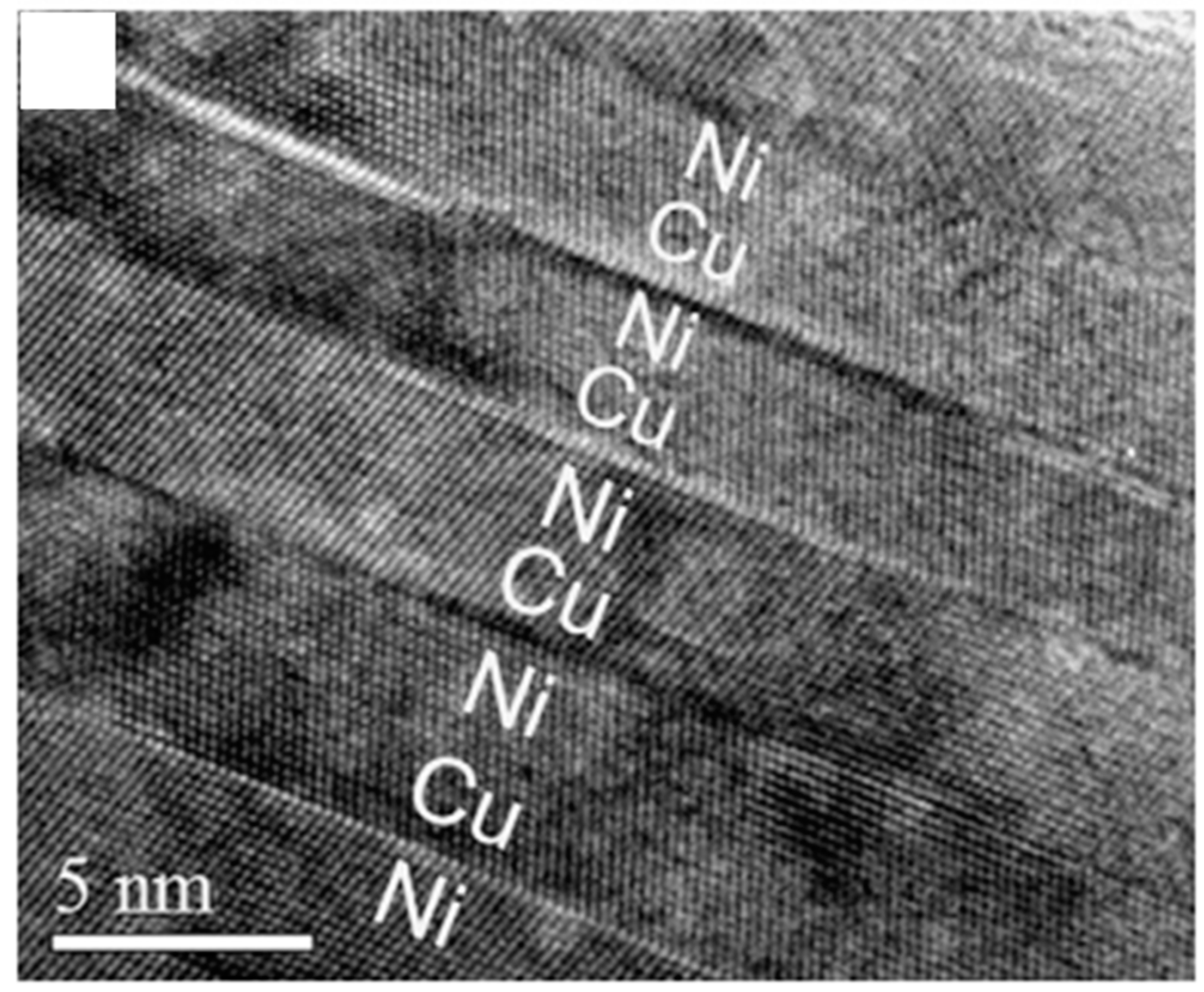
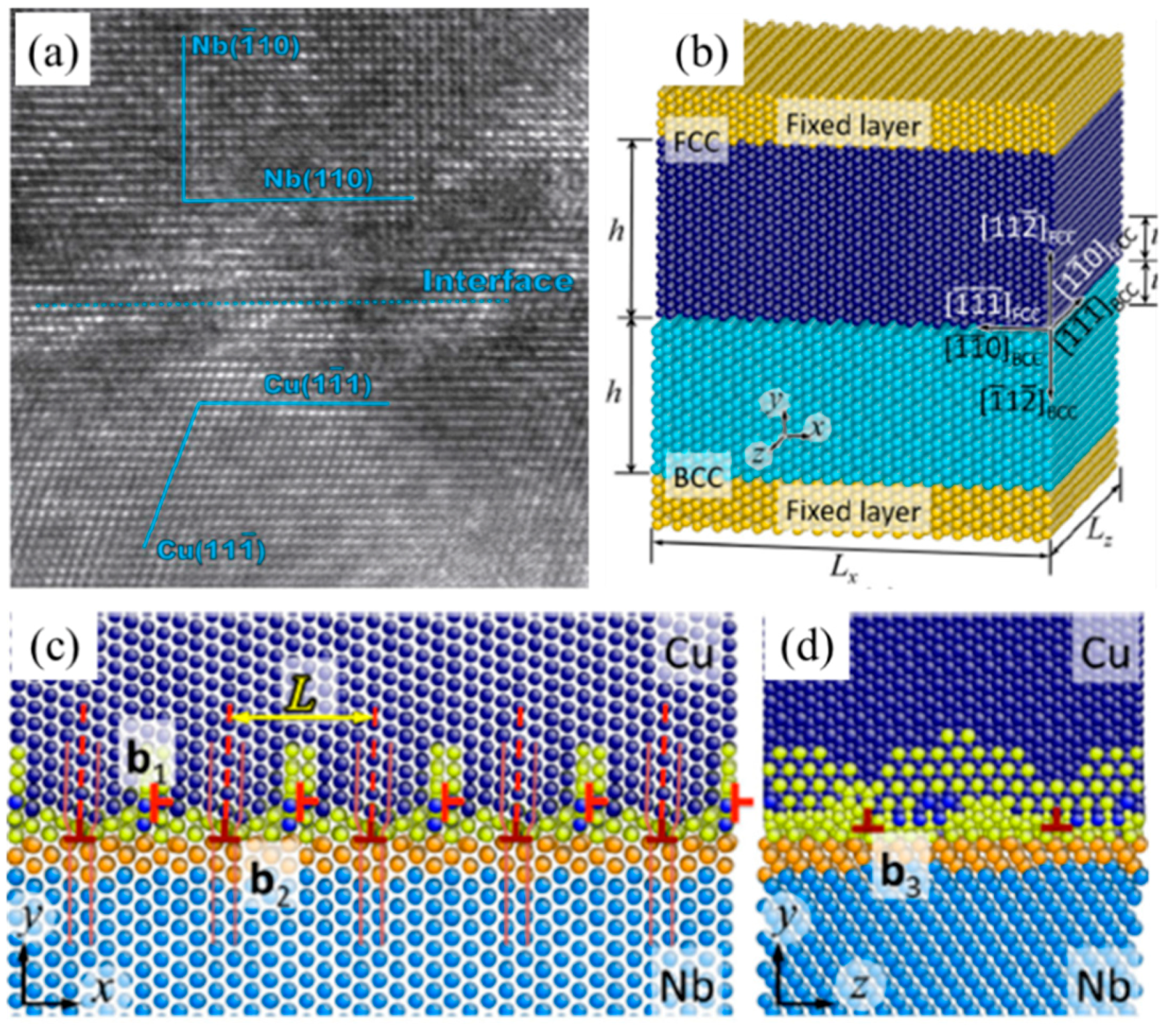
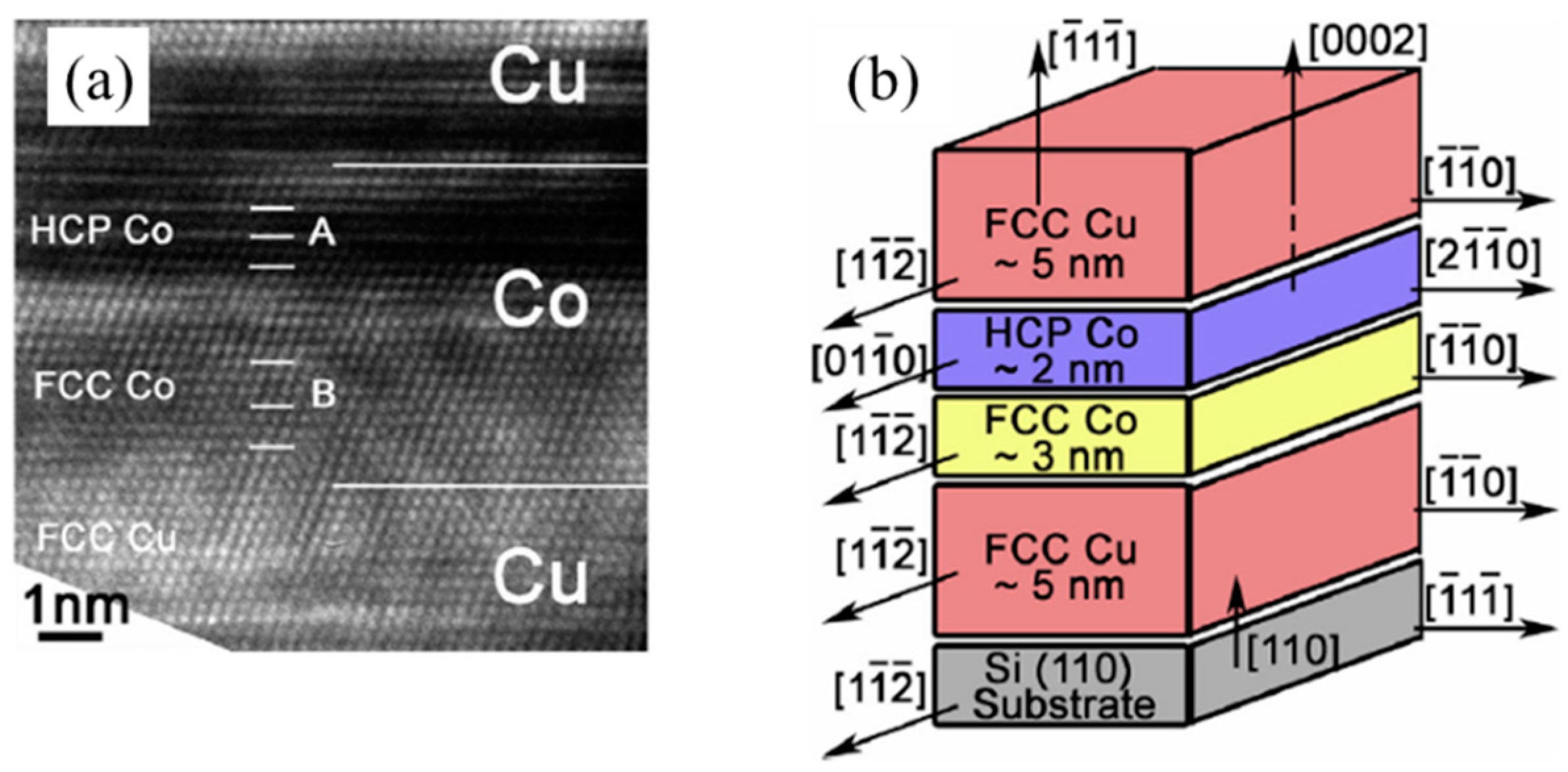
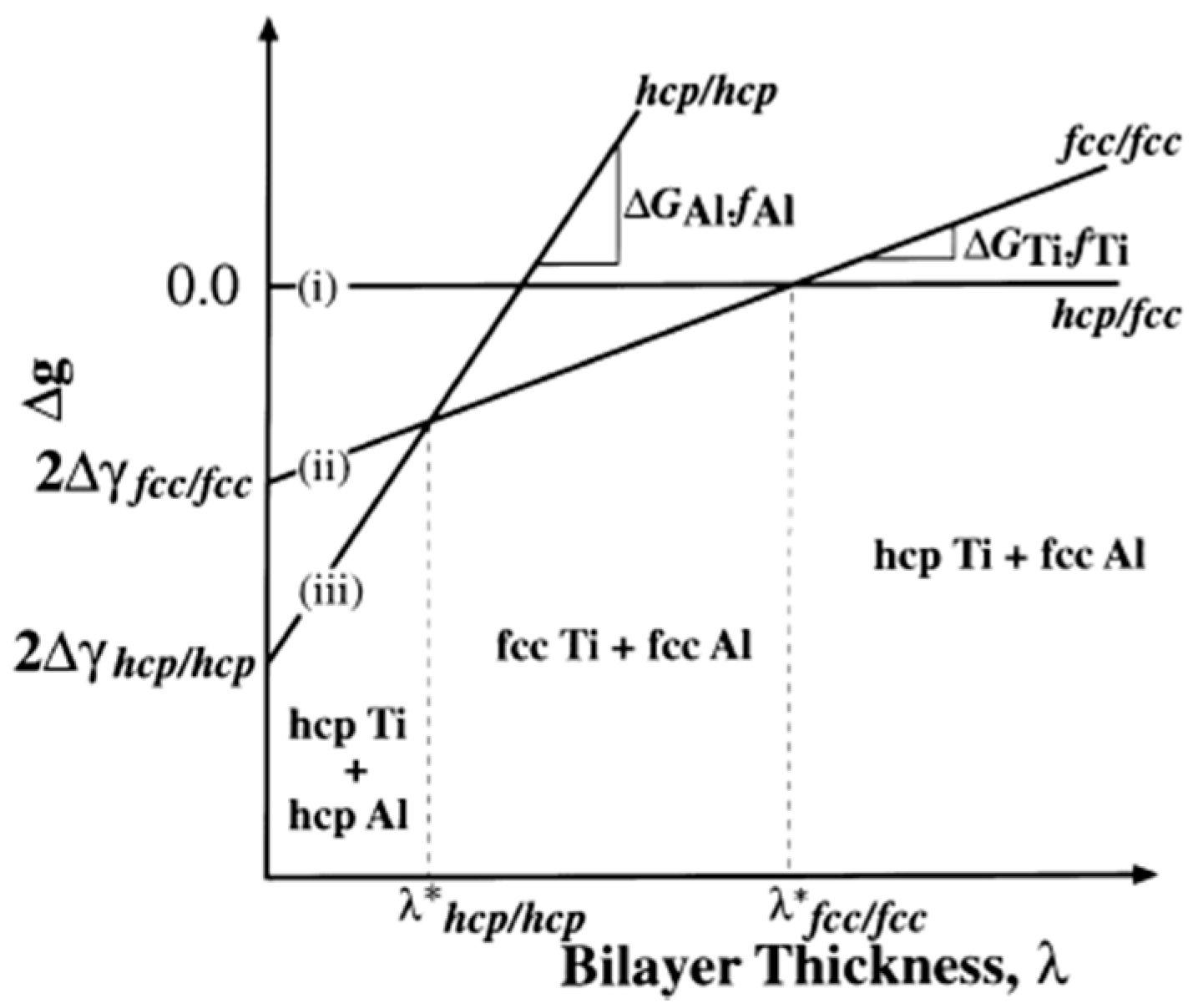
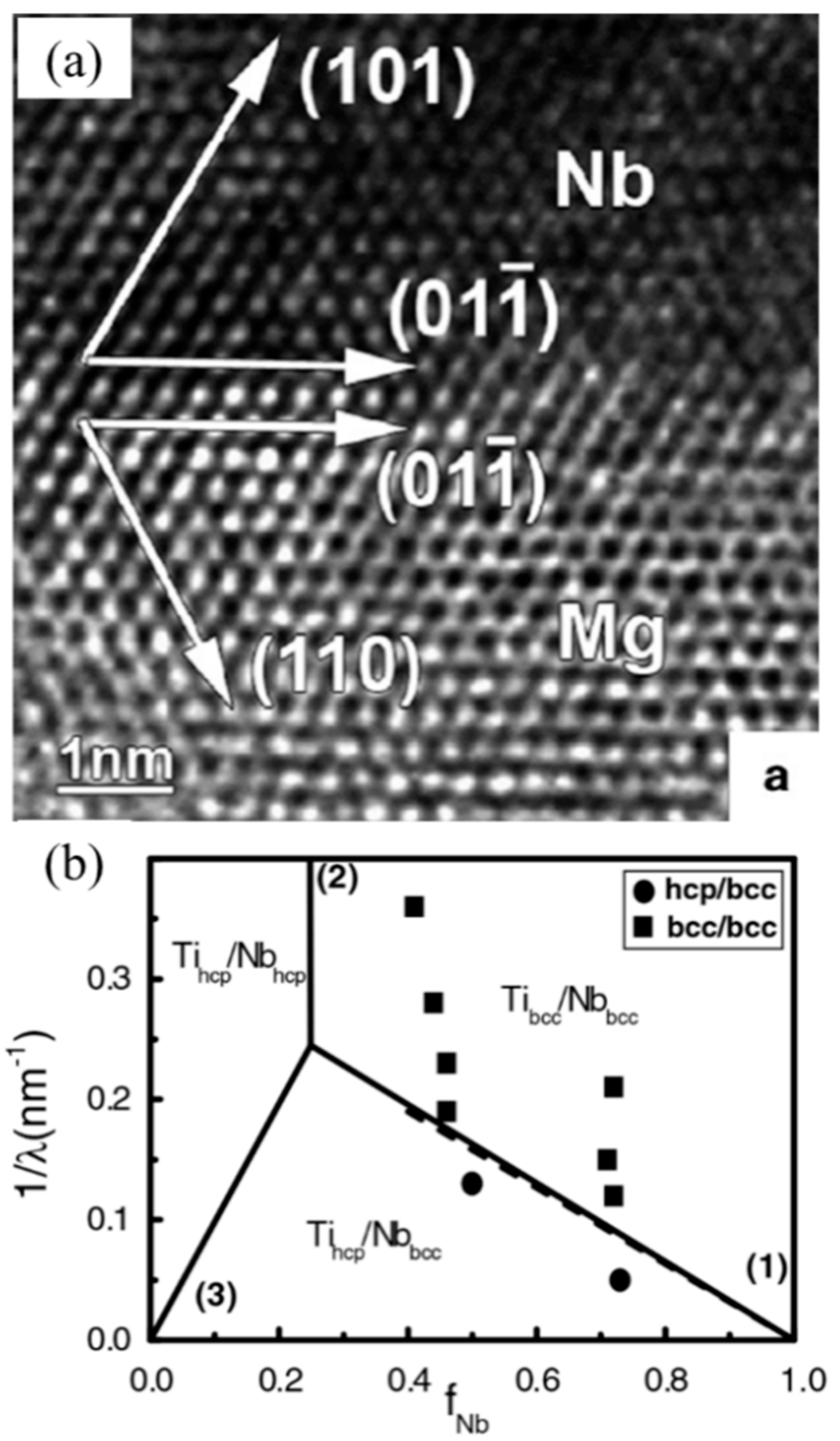


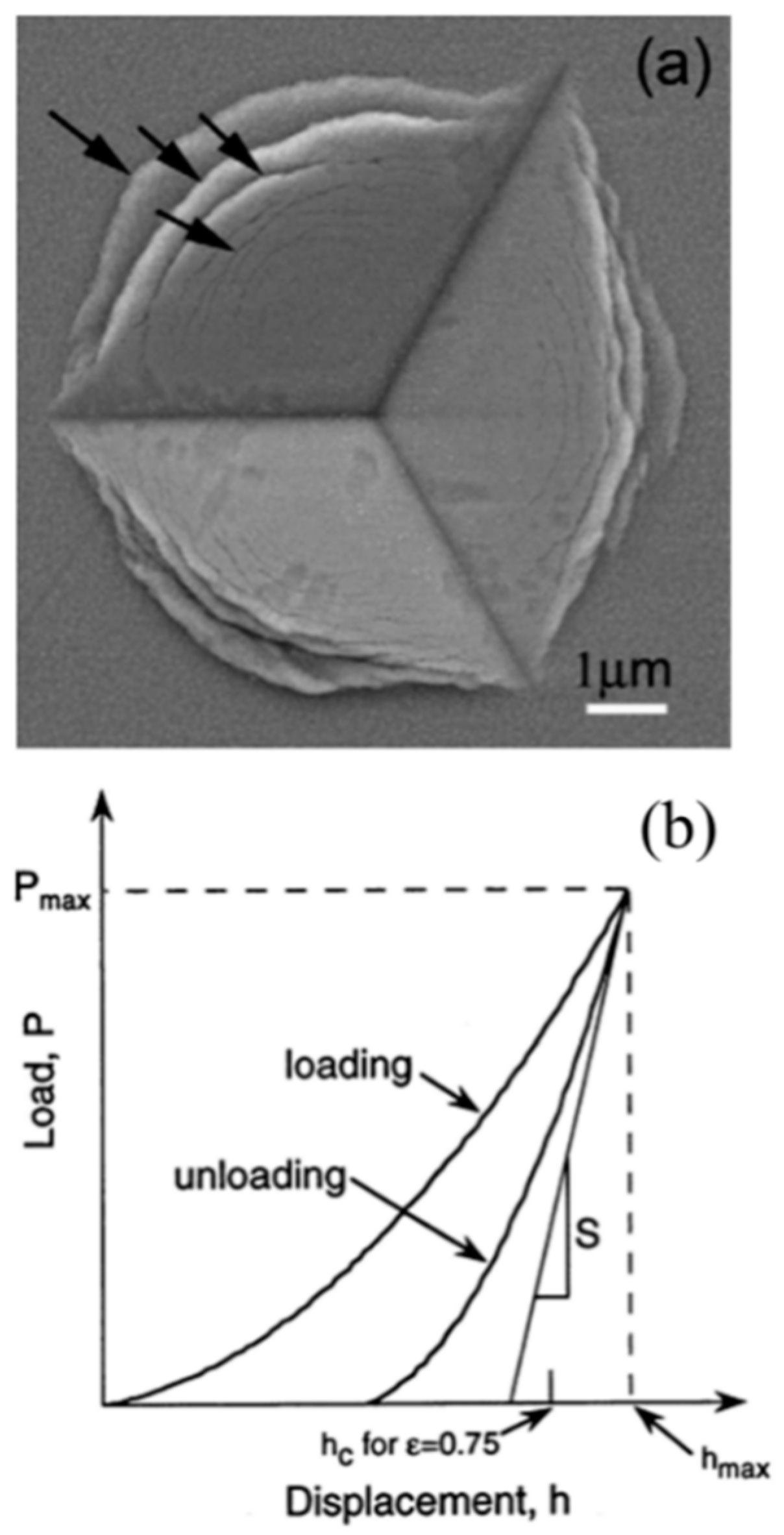
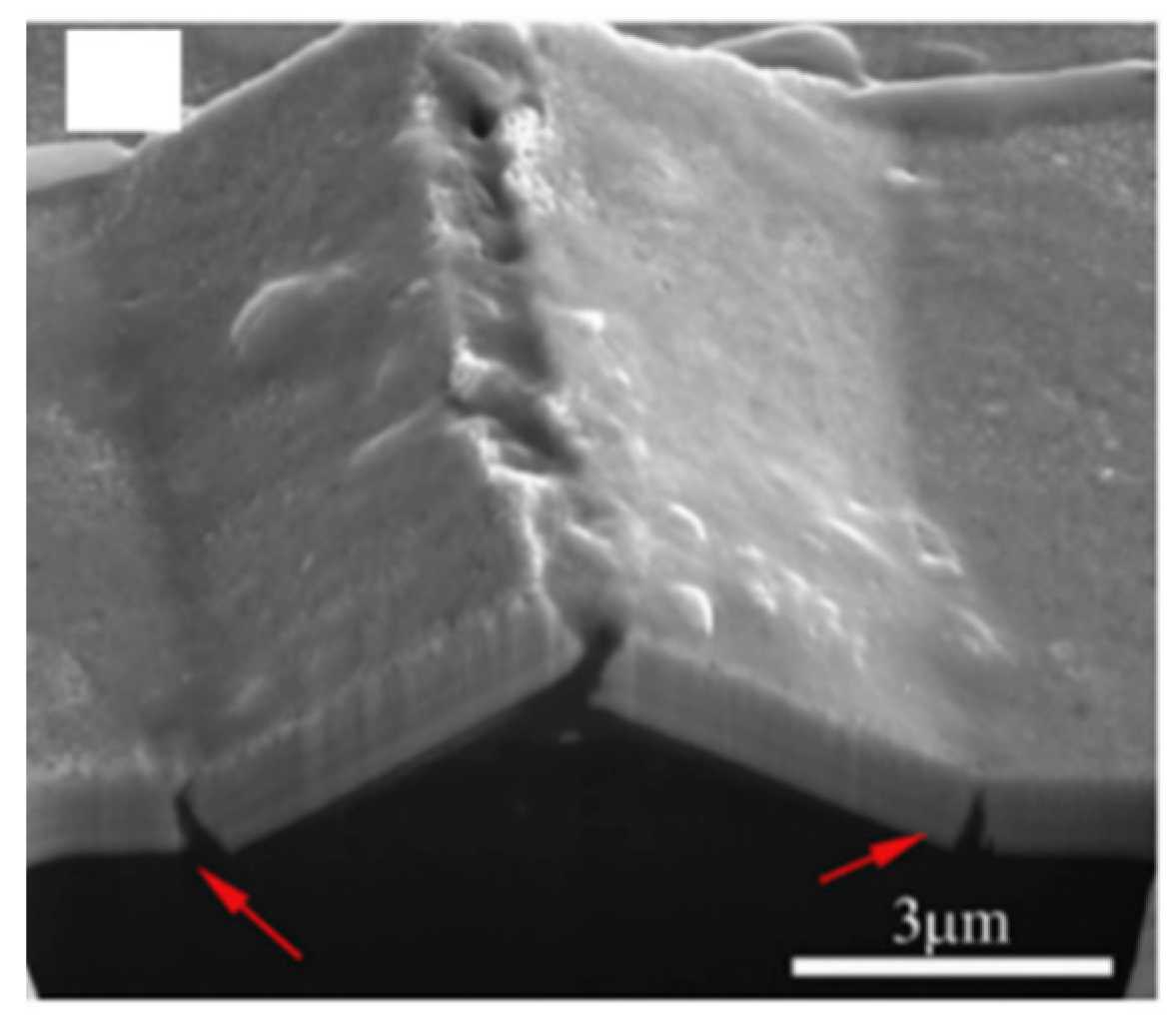
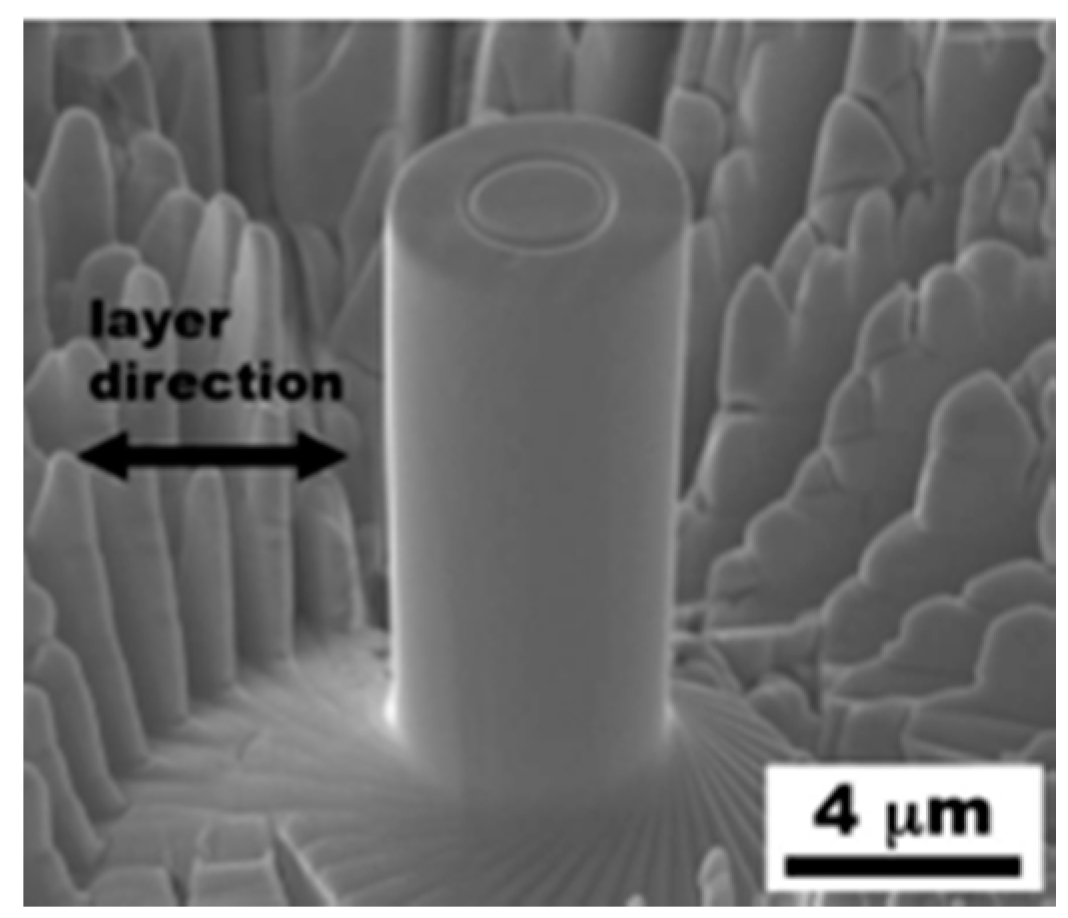

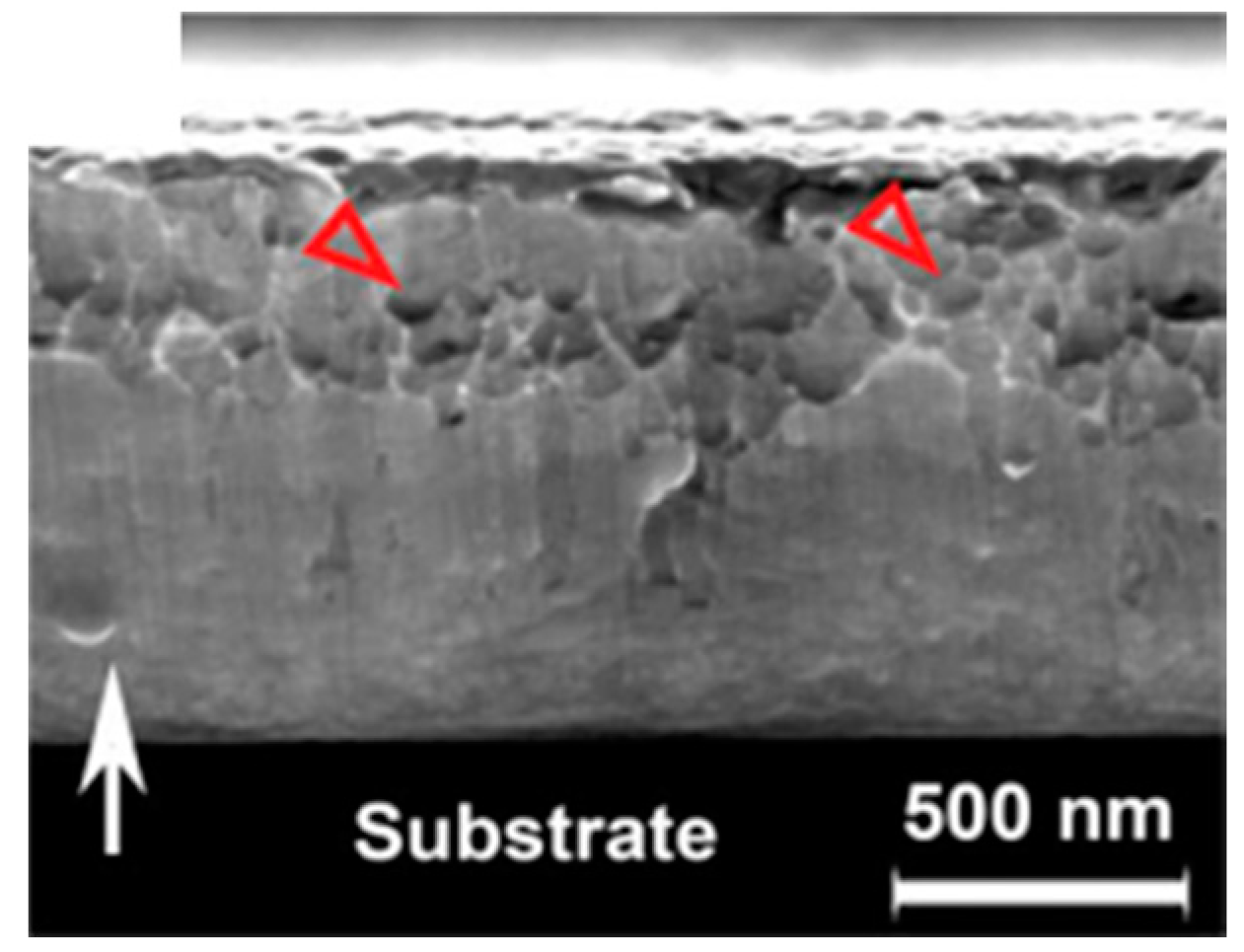

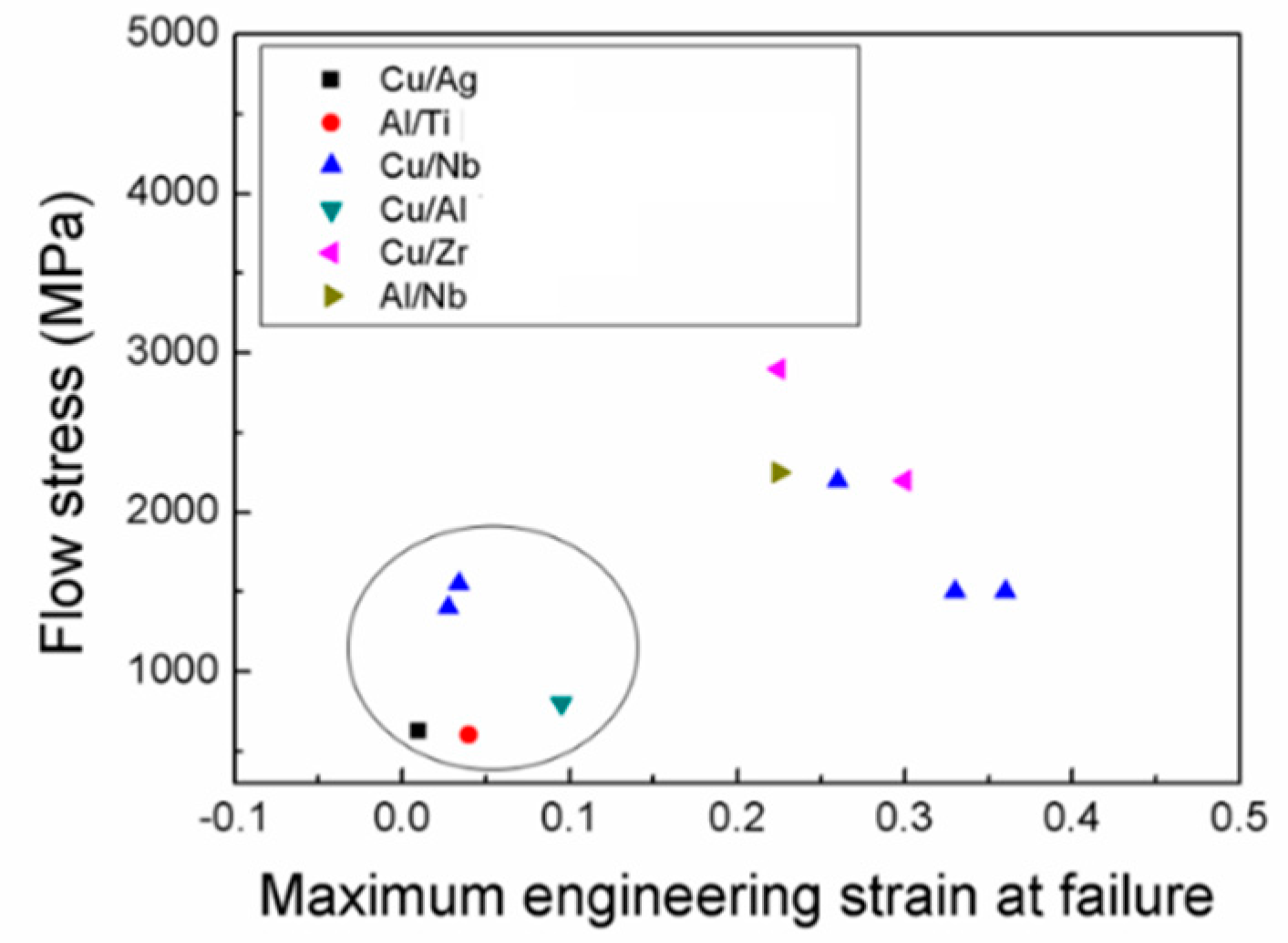
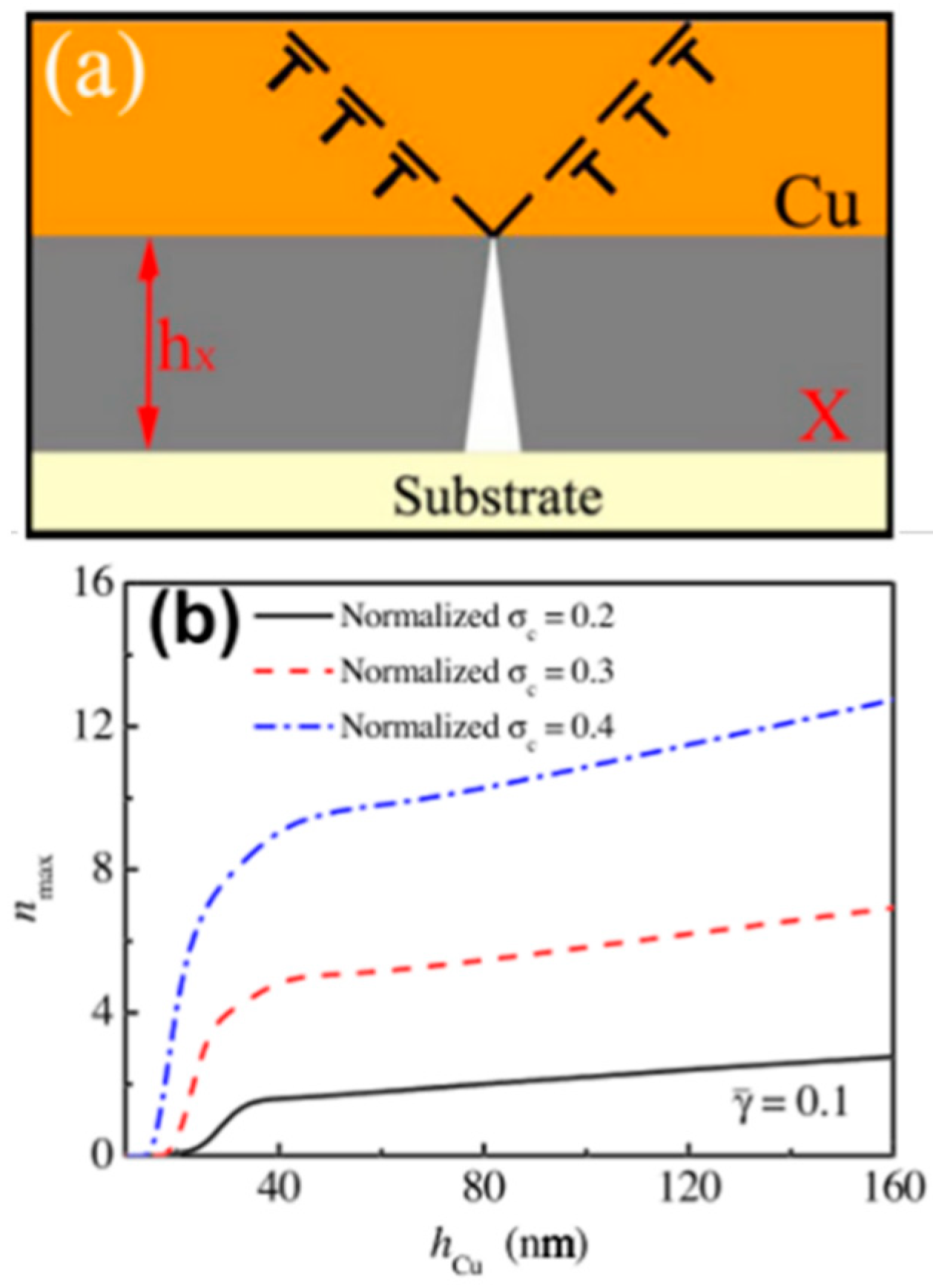
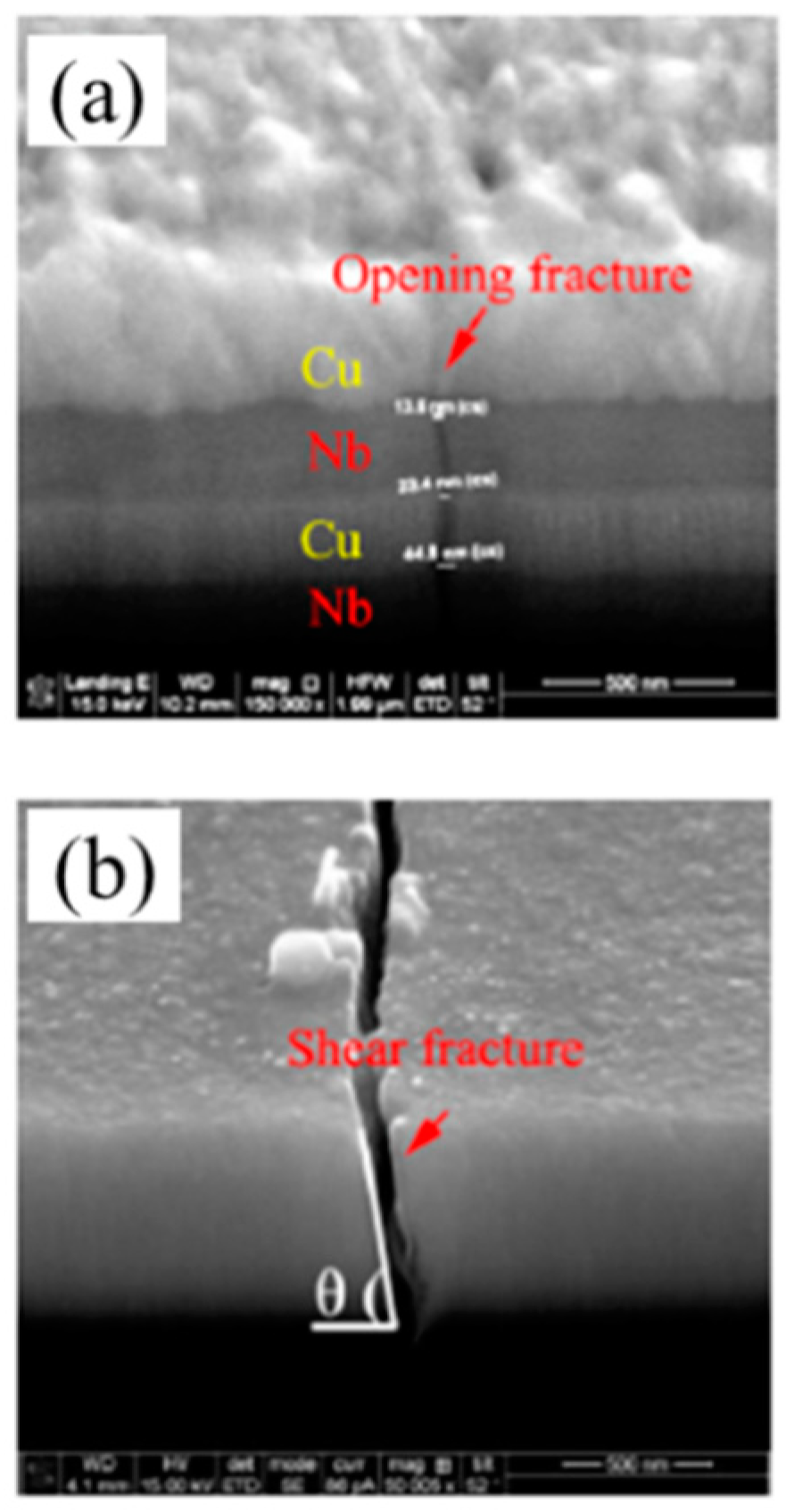
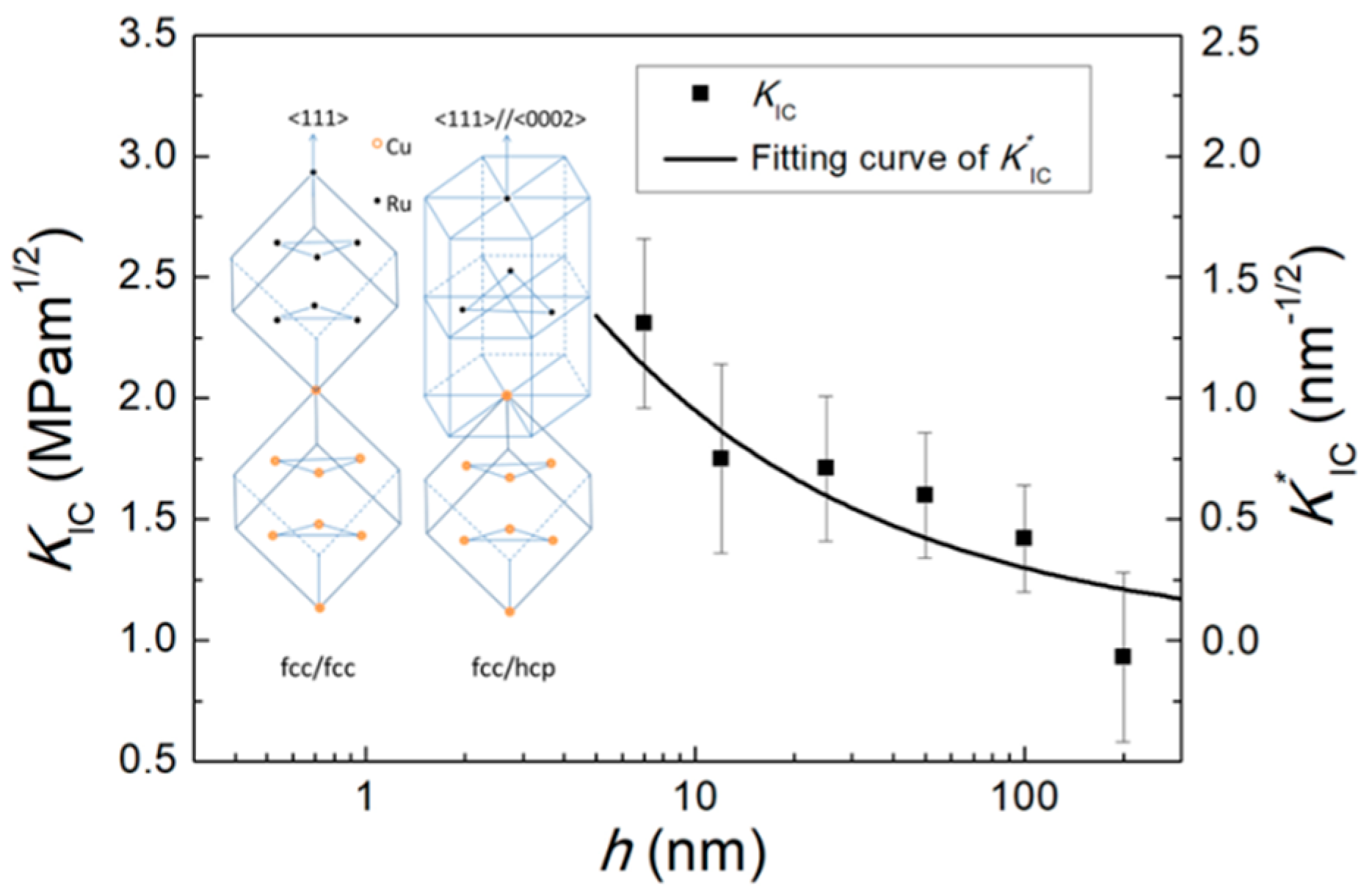
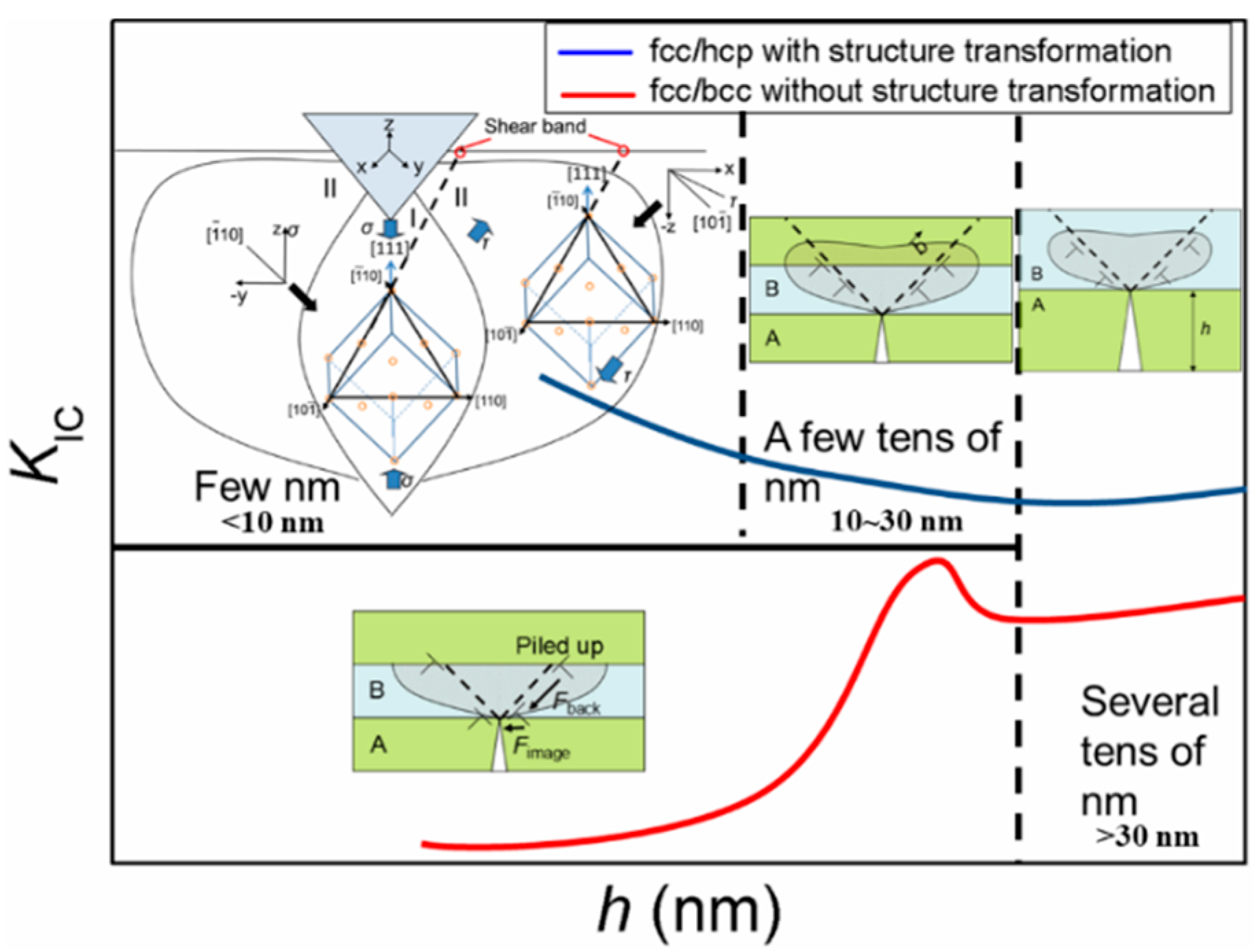
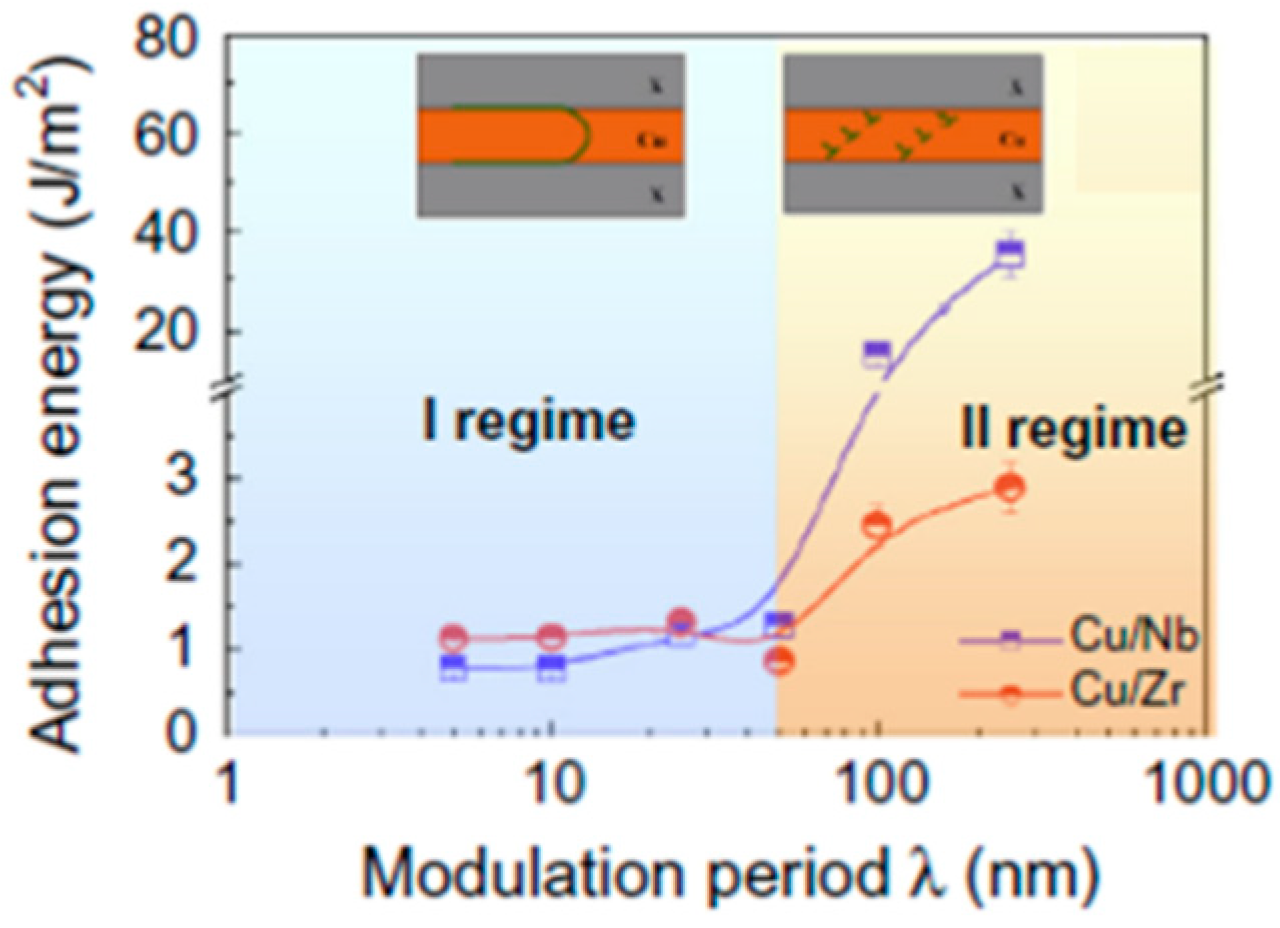
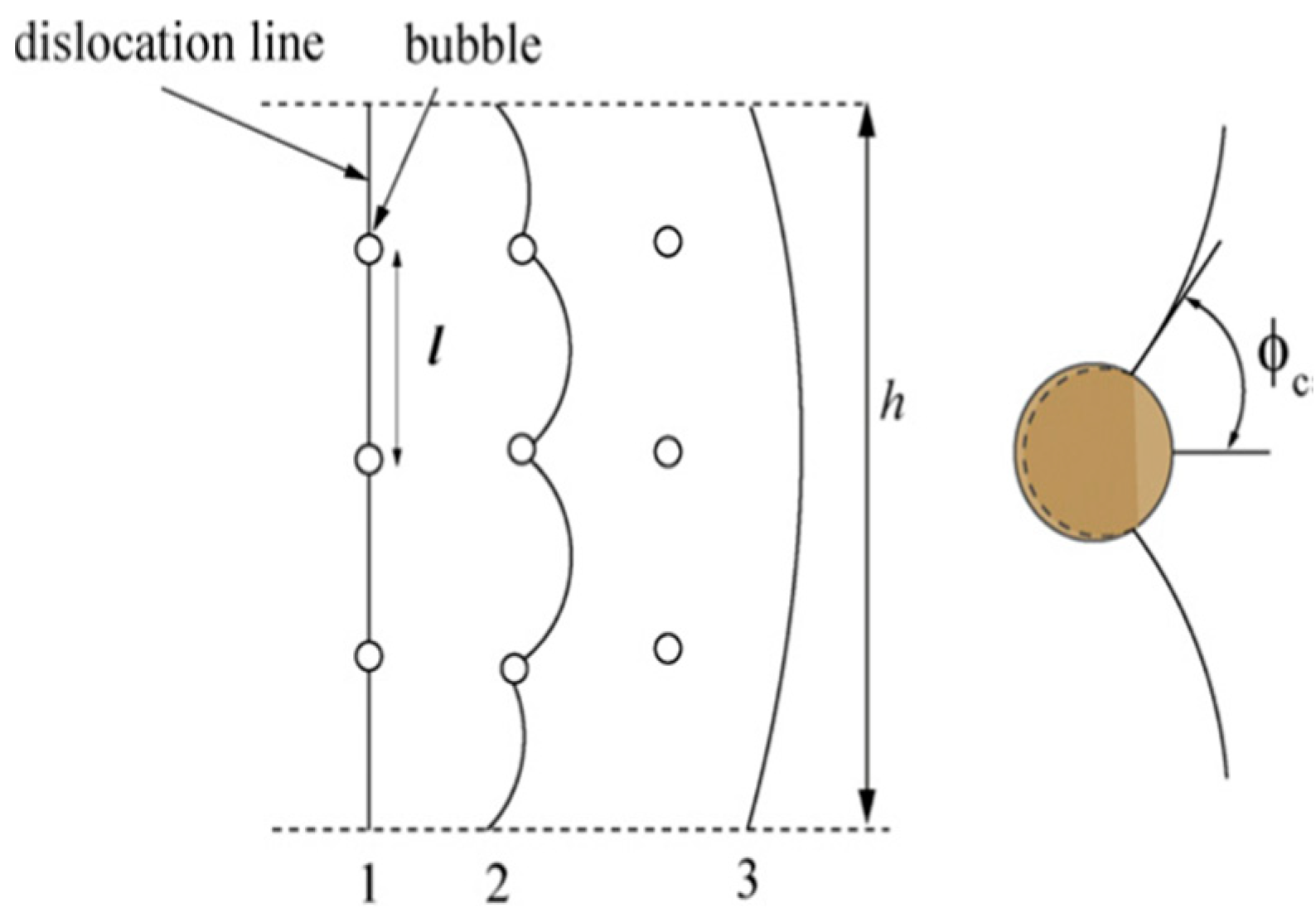
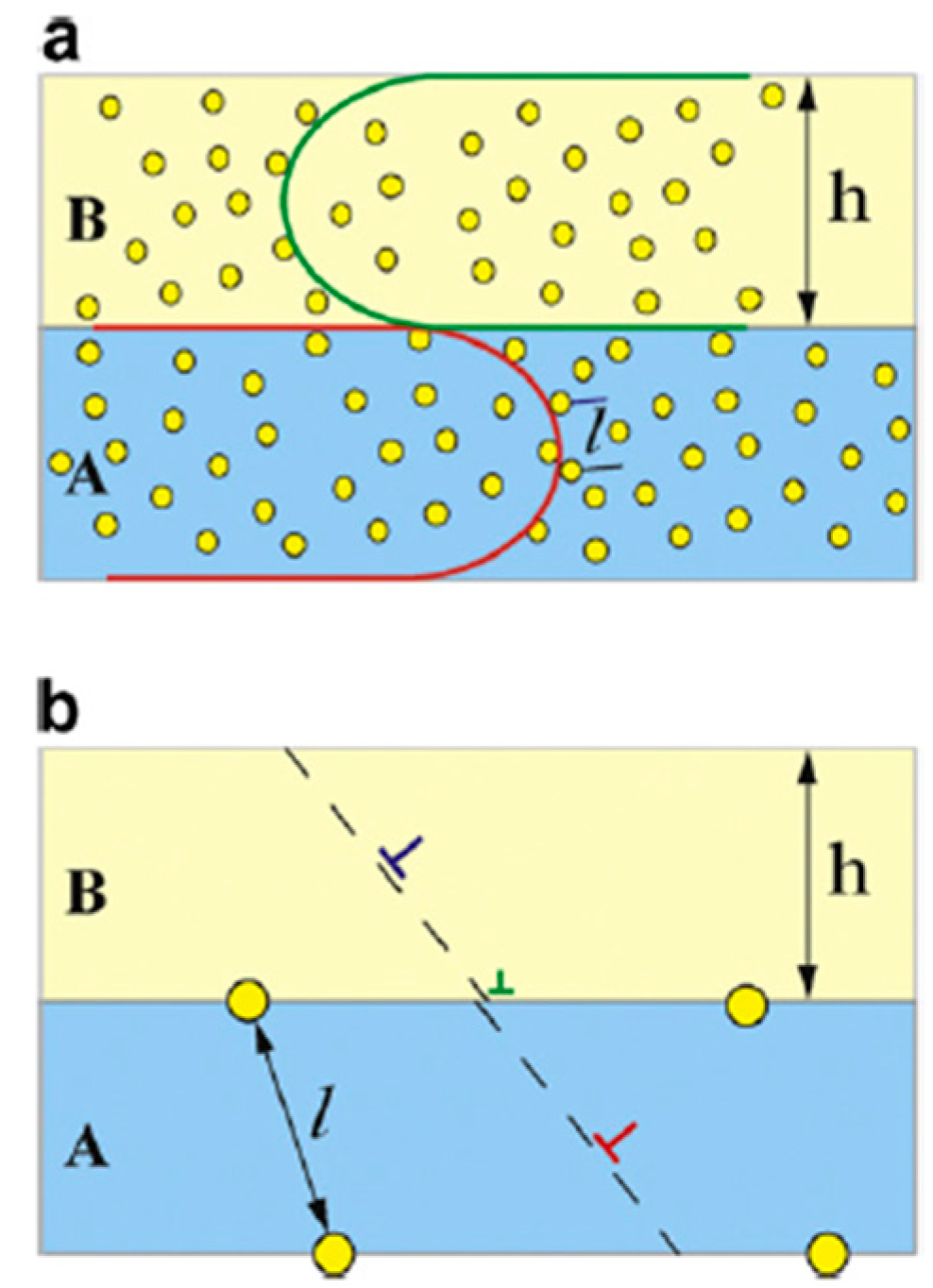

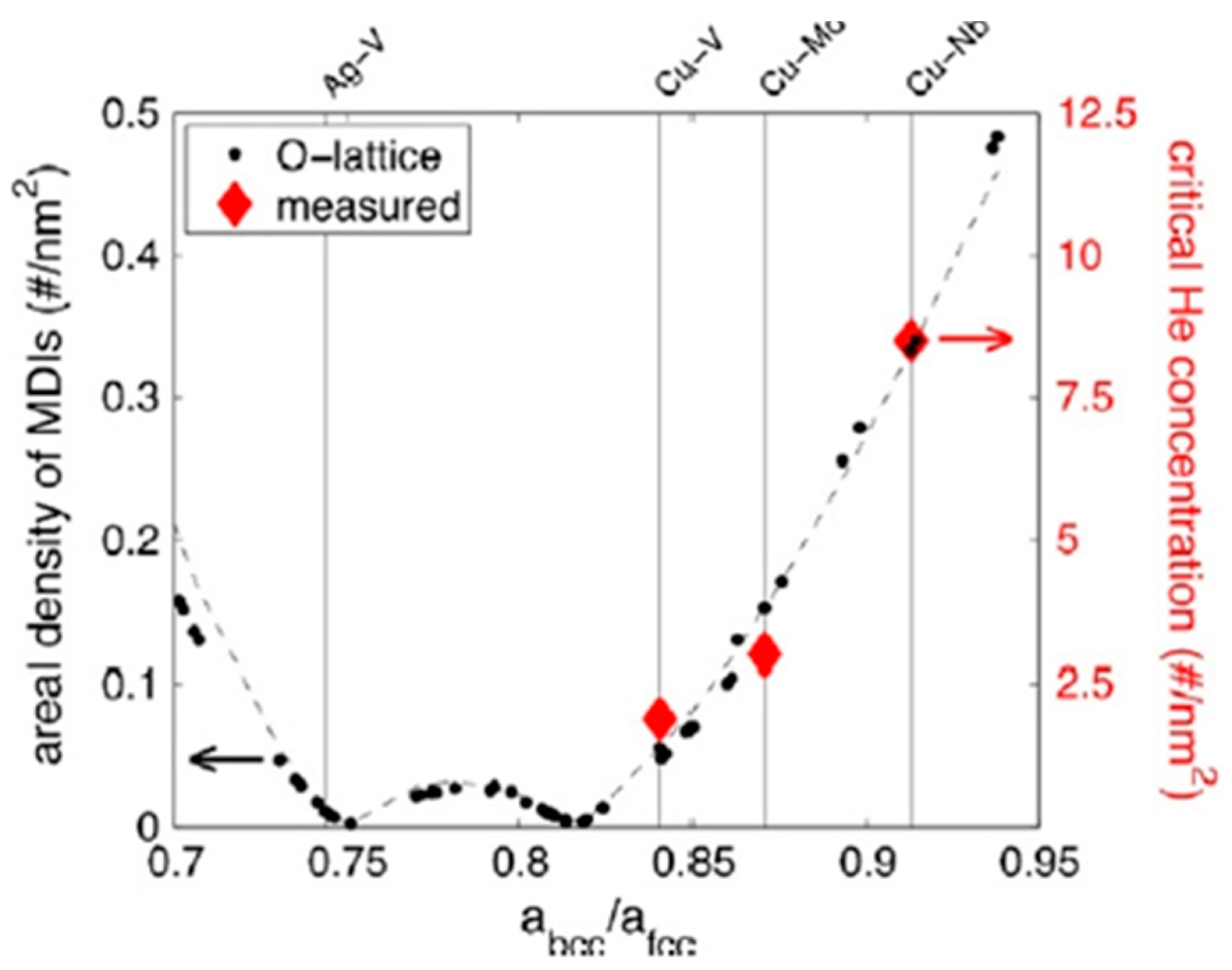
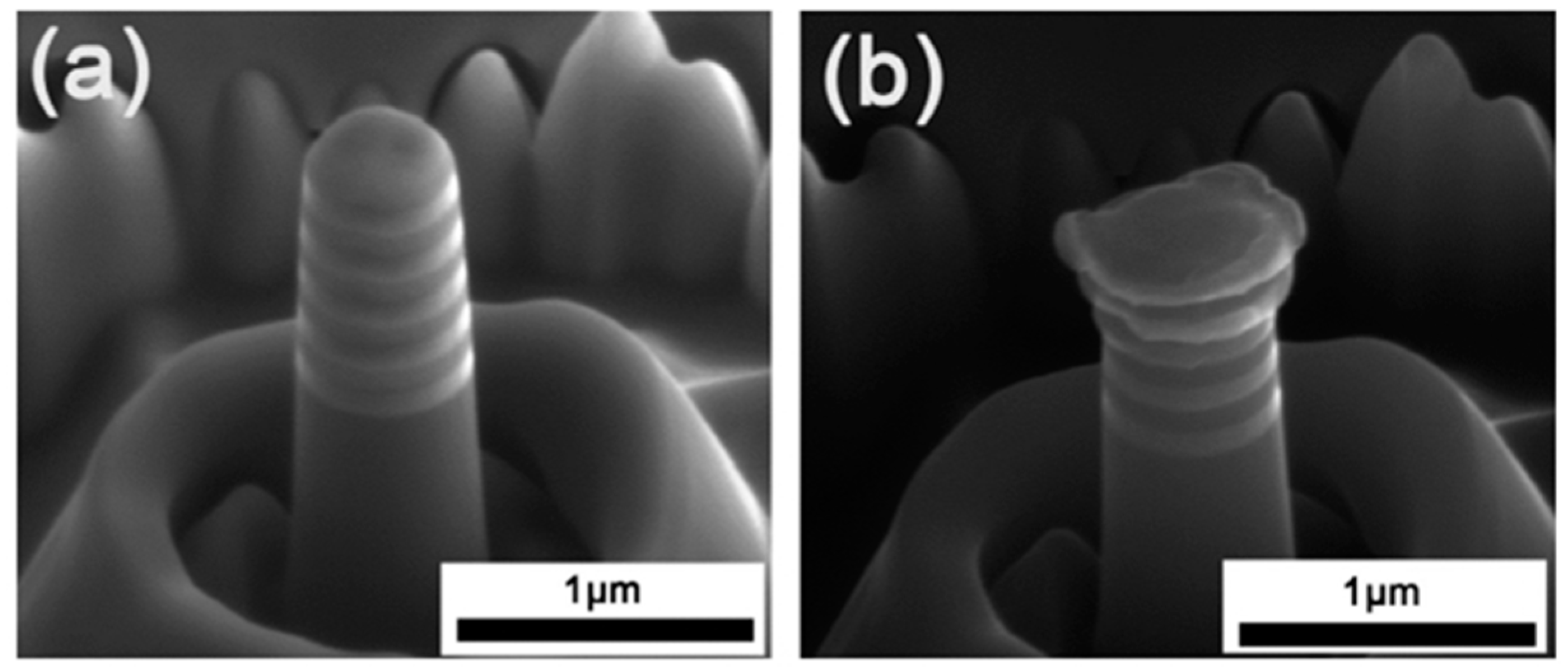
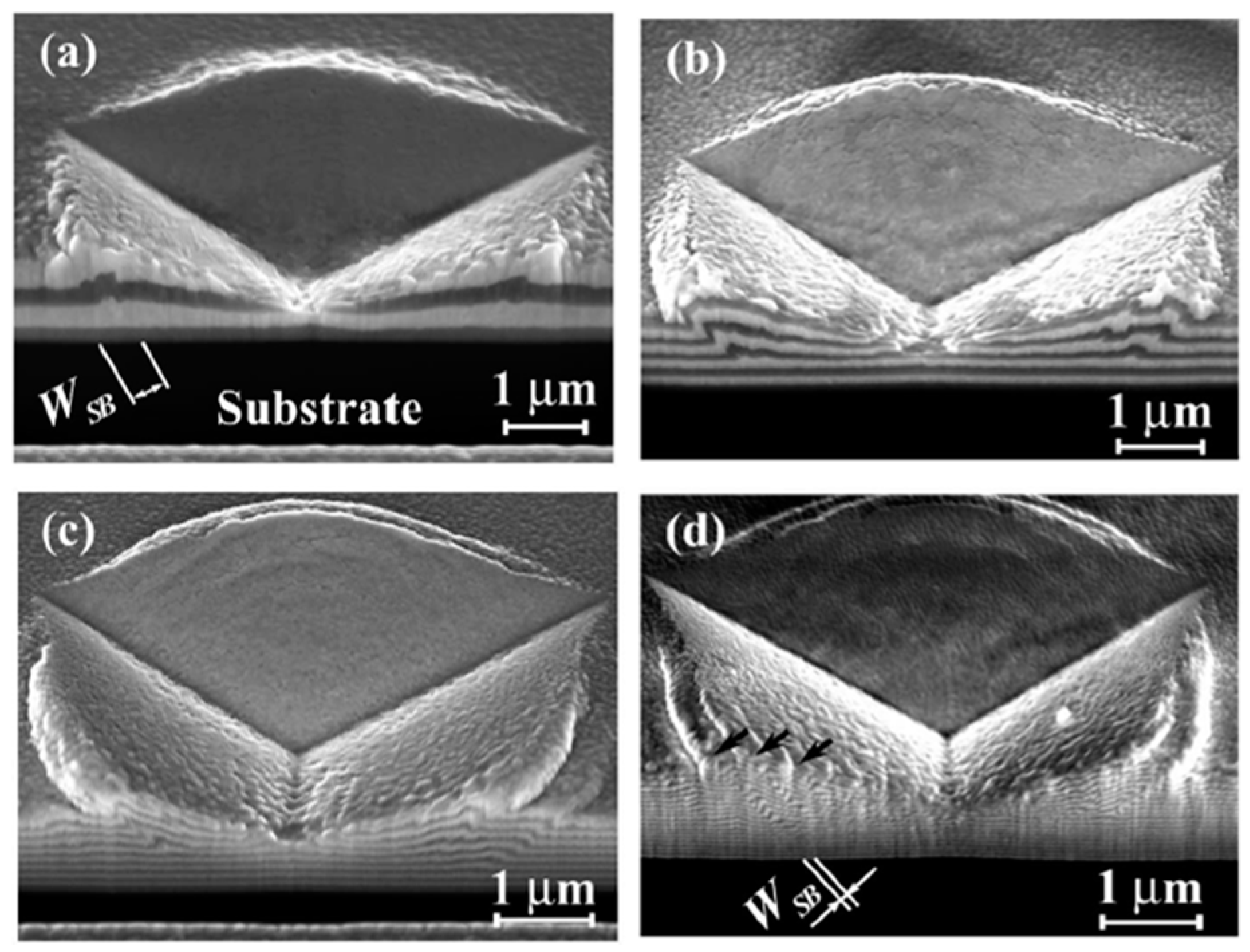
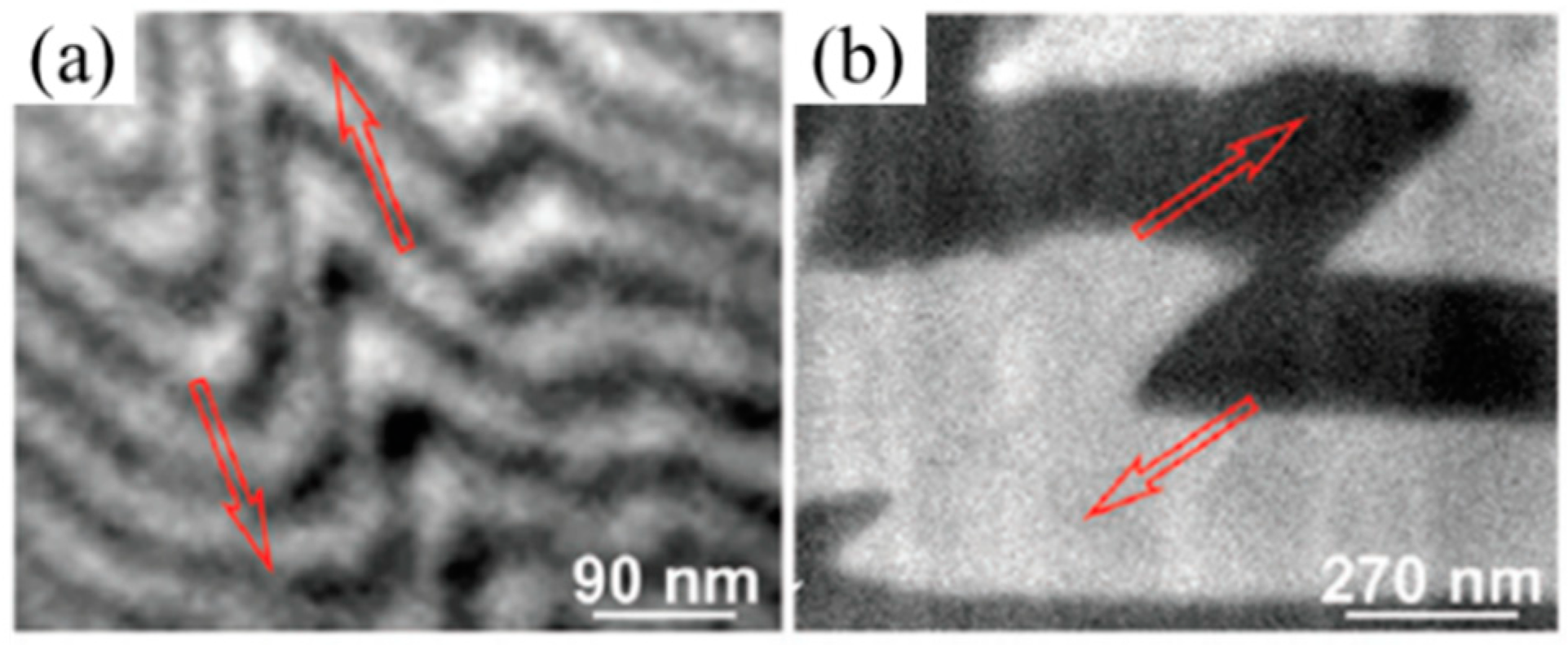


| Systems (Cu/X) | Layer Thickness, h nm | Peak Hardness, Hmax GPa | Hmax/Hrom | References |
|---|---|---|---|---|
| Cu/Ni | 1.75 | 6.83 | 1.89 | [17] |
| Cu/Au | 25 | 2.45 | 1.23 | [88] |
| Cu/Co | 1 | 6 | 1.60 | [20] |
| Cu/Nb | 1.2 | 7.02 | 3.15 | [78] |
| Cu/Fe | 5 | 4.8 | 1.49 | [30] |
| Cu/V | 2.5 | 5.2 | 1.56 | [89] |
| Cu/Cr | 10 | 6.8 | 1.36 | [1] |
| Cu/W | 4 | 8.9 | 1.25 | [90] |
| Cu/Ta | 30 | 7.0 | 1.08 | [91] |
| Cu/Zr | 5 | 5.8 | 1.54 | [92] |
| Cu/Ru | 5 | 8.1 | 1.16 | [48] |
| Systems (Ag/X) | Layer Thickness, h nm | Peak Hardness, Hmax GPa | Hmax/Hrom | References |
|---|---|---|---|---|
| Ag/Cu | 2 | 4.6 | 1.70 | [93] |
| Ag/Ni | 5 | 6.2 | 1.48 | [94] |
| Ag/Al | 5 | 5.5 | 3.67 | [4] |
| Ag/Co | 3.5 | 4.9 | 1.23 | [39] |
| Ag/Nb | 2 | 7.9 | 2.26 | [95] |
| Ag/V | 4 | 5.7 | 1.63 | [96] |
| Ag/Fe | 2 | 6.36 | 1.51 | [97] |
| Ag/W | 50 | 3.36 | 0.25 | [98] |
© 2018 by the authors. Licensee MDPI, Basel, Switzerland. This article is an open access article distributed under the terms and conditions of the Creative Commons Attribution (CC BY) license (http://creativecommons.org/licenses/by/4.0/).
Share and Cite
Zhou, Q.; Ren, Y.; Du, Y.; Hua, D.; Han, W. Cracking and Toughening Mechanisms in Nanoscale Metallic Multilayer Films: A Brief Review. Appl. Sci. 2018, 8, 1821. https://doi.org/10.3390/app8101821
Zhou Q, Ren Y, Du Y, Hua D, Han W. Cracking and Toughening Mechanisms in Nanoscale Metallic Multilayer Films: A Brief Review. Applied Sciences. 2018; 8(10):1821. https://doi.org/10.3390/app8101821
Chicago/Turabian StyleZhou, Qing, Yue Ren, Yin Du, Dongpeng Hua, and Weichao Han. 2018. "Cracking and Toughening Mechanisms in Nanoscale Metallic Multilayer Films: A Brief Review" Applied Sciences 8, no. 10: 1821. https://doi.org/10.3390/app8101821
APA StyleZhou, Q., Ren, Y., Du, Y., Hua, D., & Han, W. (2018). Cracking and Toughening Mechanisms in Nanoscale Metallic Multilayer Films: A Brief Review. Applied Sciences, 8(10), 1821. https://doi.org/10.3390/app8101821






